Don't wanna be here? Send us removal request.
Text
Rogue

Rogues rely on skill, stealth, and their foes’ vulnerabilities to get the upper hand in any situation. They have a knack for finding the solution to just about any problem, demonstrating a resourcefulness and versatility that is the cornerstone of any successful adventuring party.
Rogues devote as much effort to mastering the use of a variety of skills as they do to perfecting their combat abilities, giving them a broad expertise that few other characters can match. Many rogues focus on stealth and deception, while others refine the skills that help them in a dungeon environment, such as climbing, finding and disarming traps, and opening locks. When it comes to combat, rogues prioritize cunning over brute strength. A rogue would rather make one precise strike, placing it exactly where the attack will hurt the target most, than wear an opponent down with a barrage of attacks. Rogues have an almost supernatural knack for avoiding danger, and a few learn magical tricks to supplement their other abilities.
Every town and city has its share of rogues. Most of them live up to the worst stereotypes of the class, making a living as burglars, assassins, cutpurses, and con artists. Often, these scoundrels are organized into thieves’ guilds or crime families. Plenty of rogues operate independently, but even they sometimes recruit apprentices to help them in their scams and heists. A few rogues make an honest living as locksmiths, investigators, or exterminators, which can be a dangerous job in a world where dire rats—and wererats—haunt the sewers. As adventurers, rogues fall on both sides of the law. Some are hardened criminals who decide to seek their fortune in treasure hoards, while others take up a life of adventure to escape from the law. Some have learned and perfected their skills with the explicit purpose of infiltrating ancient ruins and hidden crypts in search of treasure.
As you create your rogue character, consider the character’s relationship to the law. Do you have a criminal past—or present? Are you on the run from the law or from an angry thieves’ guild master? Or did you leave your guild in search of bigger risks and bigger rewards? Is it greed that drives you in your adventures, or some other desire or ideal? What was the trigger that led you away from your previous life? Did a great con or heist gone terribly wrong cause you to re-evaluate your career? Maybe you were lucky and a successful robbery gave you the coin you needed to escape the squalor of your life. Did wanderlust finally call you away from your home? Perhaps you suddenly found yourself cut off from your family or your mentor, and you had to find a new means of support. Or maybe you made a new friend—another member of your adventuring party—who showed you new possibilities for earning a living and employing your particular talents.
HIT POINTS: 1d8 Per Rogue Level
HIT POINTS AT 1st LEVEL: 1d8 + CON
PROFICIENCIES
ARMOUR: Light armour.
WEAPONS: Simple weapons, Hand crossbows, Longswords, Rapiers, Shortswords
TOOLS: Thieve’s tools
SAVING THROWS: Dexterity, Intelligence
SKILLS: Acrobatics, Athletics, Deception, Insight, Intimidation, Investigation, Perception, Performance, Persuasion, Sleight of Hand, and Stealth (Choose 4)
STARTING EQUIPMENT
1. A rapier OR A shortsword
2. A shortbow and quiver of 20 arrows OR A shortsword
3. A burglar’s pack OR A dungeoneer’s pack OR An explorer’s pack
4. Leather armour AND Two daggers AND Thieve’s tools

EXPERTISE
At 1st level, choose two of your skill proficiencies, or one of your skill proficiencies and your proficiency with thieves’ tools. Your proficiency bonus is doubled for any ability check you make that uses either of the chosen proficiencies. At 6th level, you can choose two more of your proficiencies (in skills or with thieves’ tools) to gain this benefit.
SNEAK ATTACK
Beginning at 1st level, you know how to strike subtly and exploit a foe’s distraction. Once per turn, you can deal an extra 1d6 damage to one creature you hit with an attack if you have advantage on the attack roll. The attack must use a finesse or a ranged weapon. You don’t need advantage on the attack roll if another enemy of the target is within 5 feet of it, that enemy isn’t incapacitated, and you don’t have disadvantage on the attack roll. The amount of the extra damage increases as you gain levels in this class, as shown in the Sneak Attack column of the Rogue table.
THIEVES’ CANT
During your rogue training you learned thieves’ cant, a secret mix of dialect, jargon, and code that allows you to hide messages in seemingly normal conversation. Only another creature that knows thieves’ cant understands such messages. It takes four times longer to convey such a message than it does to speak the same idea plainly. In addition, you understand a set of secret signs and symbols used to convey short, simple messages, such as whether an area is dangerous or the territory of a thieves’ guild, whether loot is nearby, or whether the people in an area are easy marks or will provide a safe house for thieves on the run.
CUNNING ACTION
Starting at 2nd level, your quick thinking and agility allow you to move and act quickly. You can take a bonus action on each of your turns in combat. This action can be used only to take the Dash, Disengage, or Hide action.
ROGUISH ARCHETYPE
At 3rd level, you choose an archetype that you emulate in the exercise of your rogue abilities: Thief, detailed at the end of the class description, or one from another source. Your archetype choice grants you features at 3rd level and then again at 9th, 13th, and 17th level.
ABILITY SCORE IMPROVEMENT
When you reach 4th level, and again at 8th, 10th, 12th, 16th, and 19th level, you can increase one ability score of your choice by 2, or you can increase two ability scores of your choice by 1. As normal, you can’t increase an ability score above 20 using this feature.
UNCANNY DODGE
Starting at 5th level, when an attacker that you can see hits you with an attack, you can use your reaction to halve the attack’s damage against you.
EXPERTISE
At 6th level, choose two more of your skill proficiencies, or one more of your skill proficiencies and your proficiency with thieves’ tools. Your proficiency bonus is doubled for any ability check you make that uses either of the chosen proficiencies.
EVASION
Beginning at 7th level, you can nimbly dodge out of the way of certain area effects, such as an ancient red dragon’s fiery breath or an ice storm spell. When you are subjected to an effect that allows you to make a Dexterity saving throw to take only half damage, you instead take no damage if you succeed on the saving throw, and only half damage if you fail.
RELIABLE TALENT
By 11th level, you have refined your chosen skills until they approach perfection. Whenever you make an ability check that lets you add your proficiency bonus, you can treat a d20 roll of 9 or lower as a 10.
BLINDSENSE
Starting at 14th level, if you are able to hear, you are aware of the location of any hidden or invisible creature within 10 feet of you.
SLIPPERY MIND
By 15th level, you have acquired greater mental strength. You gain proficiency in Wisdom saving throws.
ELUSIVE
Beginning at 18th level, you are so evasive that attackers rarely gain the upper hand against you. No attack roll has advantage against you while you aren’t incapacitated.
STROKE OF LUCK
At 20th level, you have an uncanny knack for succeeding when you need to. If your attack misses a target within range, you can turn the miss into a hit. Alternatively, if you fail an ability check, you can treat the d20 roll as a 20. Once you use this feature, you can’t use it again until you finish a short or long rest.

ROGUISH ARCHETYPES
Rogues have many features in common, including their emphasis on perfecting their skills, their precise and deadly approach to combat, and their increasingly quick reflexes. But different rogues steer those talents in varying directions, embodied by the rogue archetypes. Your choice of archetype is a reflection of your focus—not necessarily an indication of your chosen profession, but a description of your preferred techniques.

SOULKNIFE
A Soulknife possesses powerful psionic potential. They channel this reservoir of inner magic into tangible blades of psychic energy, striking at their victims’ minds. They find easy employment as members of thieves’ guilds, being particularly sought after as assassins, since their signature psychic blades leave behind no visible wounds. As a Soulknife, your psionic abilities might have haunted you since you were a child, only revealing their potential when your psychic knives first appeared. Or you might have sought out a reclusive order of psionic assassins and spent years learning how to manifest your deadly blades.
3rd LEVEL – PSYCHIC BLADE
As a bonus action, you can create a magical blade of shimmering psychic power from one or both of your hands. While one of your hands is manifesting a blade, you can’t hold anything in that hand. You can dismiss one or both blades at any time (no action required), and they disappear if you’re incapacitated. The blade is a simple melee weapon with the finesse, light, and thrown properties. It has a normal range of 30 feet and a long range of 60 feet, and it deals 1d6 psychic damage on a hit. If you throw the blade as part of an attack, it vanishes immediately after it hits or misses its target. The blade otherwise disappears the instant it leaves your hand.
3rd LEVEL – PSIONIC ENHANCEMENT
You can focus your psionic power to give yourself an extraordinary ability. When you finish a long rest, you gain one of the following benefits of your choice, which lasts until you finish a long rest:
Telepathy
You can communicate telepathically with any creature you can see within 30 feet of you. If a creature can speak at least one language, it can respond to you telepathically.
Toughness
Your hit point maximum and your current hit points increase by an amount equal to your Intelligence modifier plus your rogue level.
Walking Speed
Increase your walking speed by 5 feet.
9th LEVEL – TERRIFYING BLADE
Your psychic blades can now stoke terror within a target: When you damage a creature with your Psychic Blade, you can force the target to make a Wisdom saving throw (DC equal to 8 + your proficiency bonus + your Intelligence modifier). On a failed save, the creature is frightened of you until the start of your next turn. On a successful save, the creature isn’t frightened and is immune to your Terrifying Blade for 24 hours.
13th LEVEL – PSYCHIC VEIL
You can weave a veil of psionic static to mask your physical presence. As an action, you can magically become invisible, along with anything you are wearing or carrying, for 10 minutes. This invisibility ends if you make an attack or if you force a creature to make a saving throw. You can use this feature a number of times equal to your Intelligence modifier (minimum of once), and you regain all expended uses when you finish a long rest.
17th LEVEL – REND MIND
You can sweep your Psychic Blade directly through a creature’s mind. As an action while you have at least one Psychic Blade manifested, you can force a creature you can see within 30 feet of you to make an Intelligence saving throw (DC equal to 10 + your proficiency bonus + your Intelligence modifier). If you are hidden from the target, it has disadvantage on the save. On a failed save, the target takes 12d6 psychic damage, and it is stunned until the start of your next turn. On a successful save, the target takes half as much damage and isn’t stunned. One of your Psychic Blades vanishes after using this feature. You can use this feature a number of times equal to your Intelligence modifier (minimum of once), and you regain all expended uses when you finish a long rest.

THE REVIVED
You’ve had a soul-shaking realization: you’ve been dead before, yet somehow you are alive again. This life isn’t your first; it might not even be your second. Your past life, or lives, are unclear to you, but you know that you passed through the gates of death. And the powers of death, or some other influence, wasn’t done with you. You might have convinced a deity to let you return to the Material Plane, perhaps you signed a deal with a fiend, or maybe you used an artefact that revived you. Whatever force brought you back, you now know the truth about yourself: that you are one of death’s representatives among the living.
3rd LEVEL – TOKENS OF PAST LIVES
You remember talents you had in your previous life. When you finish a long rest, you gain one skill or tool proficiency of your choice. You can replace this proficiency with another when you finish a long rest.
3rd LEVEL – REVIVED NATURE
Your newfound connection to death gives you the following benefits:
You have advantage on saving throws against disease and being poisoned, and you have resistance to poison damage.
You don’t need to eat, drink, or breathe.
You don’t need to sleep. When you take a long rest, you must spend at least four hours in an inactive, motionless state, rather than sleeping. In this state, you remain semi-conscious, and you can hear as normal.
3rd LEVEL – BOLTS FROM THE GRAVE
You have learned to unleash bolts of necrotic energy from within your revived body. Immediately after you use your Cunning Action, you can make a ranged spell attack against a creature within 30 feet of you, provided you haven’t used your Sneak Attack this turn. You are proficient with it, and you add your Dexterity modifier to its attack and damage rolls. A creature hit by this attack takes necrotic damage equal to your Sneak Attack. This uses your Sneak Attack for the turn.
9th LEVEL – CONNECT WITH THE DEAD
You can create a link with a spirit through their corpse. When you do so, you cast the speak with dead spell, without using a spell slot or material components. Intelligence is your spellcasting ability for this spell. Speaking with the dead in this way temporarily gives you a capability from a past life—you’re unsure whether it’s from your past or the spirit’s. When the spell ends, you gain one random benefit from the Revived Capabilities table. The benefit lasts until you finish a short or long rest.

13th LEVEL – AUDIENCE WITH DEATH
When at death’s door, you can converse with the powers of death. You have advantage on death saving throws, and whenever you make a death saving throw, your spirit can ask an entity of death a question that can be answered with “yes,” “no,” or “unknown.” The entity answers truthfully, using the knowledge of all those who have died. In addition, whenever you have 0 hit points and are healed or stabilized, you can change any of your personal characteristics: personality trait, ideal, bond, or flaw.
17th LEVEL – ETHEREAL JAUNT
Like a ghost, you have the ability to slip in and out of the Ethereal Plane. You can now use your Cunning Action to teleport to an unoccupied space within 30 feet of you. You don’t need to see that space to teleport to it, but your teleportation fails, wasting your bonus action, if you attempt to teleport through magical force that is Medium or larger, such as a wall of force. If you appear in a space occupied by another creature or filled by an object, you are immediately shunted to the nearest unoccupied space that you can occupy and take force damage equal to twice the number of feet you are shunted.

THIEF
You hone your skills in the larcenous arts. Burglars, bandits, cutpurses, and other criminals typically follow this archetype, but so do rogues who prefer to think of themselves as professional treasure seekers, explorers, delvers, and investigators. In addition to improving your agility and stealth, you learn skills useful for delving into ancient ruins, reading unfamiliar languages, and using magic items you normally couldn’t employ.
3rd LEVEL – FAST HANDS
You can use the bonus action granted by your Cunning Action to make a Dexterity (Sleight of Hand) check, use your thieves’ tools to disarm a trap or open a lock, or take the Use an Object action.
3rd LEVEL – SECOND-STORY WORK
When you choose this archetype, you gain the ability to climb faster than normal; climbing no longer costs you extra movement. In addition, when you make a running jump, the distance you cover increases by a number of feet equal to your Dexterity modifier.
9th LEVEL – SUPREME SNEAK
You have advantage on a Dexterity (Stealth) check if you move no more than half your speed on the same turn.
13th LEVEL – USE MAGIC DEVICE
You have learned enough about the workings of magic that you can improvise the use of items even when they are not intended for you. You ignore all class, race, and level requirements on the use of magic items.
17th LEVEL – THIEF’S REFLEXES
You have become adept at laying ambushes and quickly escaping danger. You can take two turns during the first round of any combat. You take your first turn at your normal initiative and your second turn at your initiative minus 10. You can’t use this feature when you are surprised.
5 notes
·
View notes
Text
Ranger
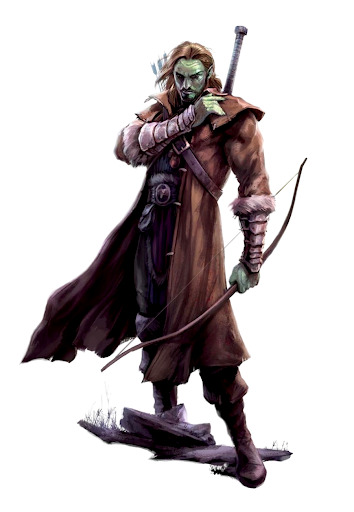
Far from the bustle of cities and towns, past the hedges that shelter the most distant farms from the terrors of the wild, amid the dense-packed trees of trackless forests and across wide and empty plains, rangers keep their unending watch.
Warriors of the wilderness, rangers specialize in hunting the monsters that threaten the edges of civilization—humanoid raiders, rampaging beasts and monstrosities, terrible giants, and deadly dragons. They learn to track their quarry as a predator does, moving stealthily through the wilds and hiding themselves in brush and rubble. Rangers focus their combat training on techniques that are particularly useful against their specific favoured foes. Thanks to their familiarity with the wilds, rangers acquire the ability to cast spells that harness nature’s power, much as a druid does. Their spells, like their combat abilities, emphasize speed, stealth, and the hunt. A ranger’s talents and abilities are honed with deadly focus on the grim task of protecting the borderlands.
Though a ranger might make a living as a hunter, a guide, or a tracker, a ranger’s true calling is to defend the outskirts of civilization from the ravages of monsters and humanoid hordes that press in from the wild. In some places, rangers gather in secretive orders or join forces with Druidic circles. Many rangers, though, are independent almost to a fault, knowing that, when a dragon or a band of orcs attacks, a ranger might be the first—and possibly the last—line of defence. This fierce independence makes rangers well suited to adventuring, since they are accustomed to life far from the comforts of a dry bed and a hot bath. Faced with city-bred adventurers who grouse and whine about the hardships of the wild, rangers respond with some mixture of amusement, frustration, and compassion. But they quickly learn that other adventurers who can carry their own weight in a fight against civilization’s foes are worth any extra burden. Coddled city folk might not know how to feed themselves or find fresh water in the wild, but they make up for it in other ways.
As you create your ranger character, consider the nature of the training that gave you your particular capabilities. Did you train with a single mentor, wandering the wilds together until you mastered the ranger’s ways? Did you leave your apprenticeship, or was your mentor slain—perhaps by the same kind of monster that became your favoured enemy? Or perhaps you learned your skills as part of a band of rangers affiliated with a Druidic circle, trained in mystic paths as well as wilderness lore. You might be self-taught, a recluse who learned combat skills, tracking, and even a magical connection to nature through the necessity of surviving in the wilds. What’s the source of your particular hatred of a certain kind of enemy? Did a monster kill someone you loved or destroy your home village? Or did you see too much of the destruction these monsters cause and commit yourself to reining in their depredations? Is your adventuring career a continuation of your work in protecting the borderlands, or a significant change? What made you join up with a band of adventurers? Do you find it challenging to teach new allies the ways of the wild, or do you welcome the relief from solitude that they offer?
HIT POINTS: 1d10 Per Ranger Level
HIT POINTS AT 1st LEVEL: 1d10 + CON
PROFICIENCIES
ARMOUR: Light armour, Medium armour, Shields
WEAPONS: Simple weapons, Martial weapons
TOOLS: None
SAVING THROWS: Strength, Dexterity
SKILLS: Animal Handling, Athletics, Insight, Investigation, Nature, Perception, Stealth, and Survival (Choose 3)
STARTING EQUIPMENT
1. Scale mail OR Leather armour
2. Two shortswords OR Two simple melee weapons
3. A dungeoneer’s pack OR An explorer’s pack
4. A longbow AND a quiver of 20 arrows
FEATURES
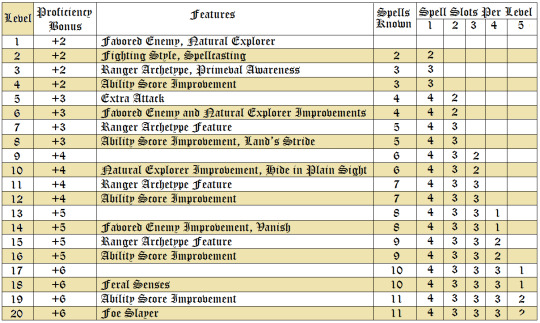
FAVOURED ENEMY
Beginning at 1st level, you have significant experience studying, tracking, hunting, and even talking to a certain type of enemy. Choose a type of favoured enemy: aberrations, beasts, celestials, constructs, dragons, elementals, fey, fiends, giants, monstrosities, oozes, plants, or undead. Alternatively, you can select two races of humanoid (such as gnolls and orcs) as favoured enemies. You have advantage on Wisdom (Survival) checks to track your favoured enemies, as well as on Intelligence checks to recall information about them. When you gain this feature, you also learn one language of your choice that is spoken by your favoured enemies, if they speak one at all. You choose one additional favoured enemy, as well as an associated language, at 6th and 14th level. As you gain levels, your choices should reflect the types of monsters you have encountered on your adventures.
NATURAL EXPLORER
You are particularly familiar with one type of natural environment and are adept at travelling and surviving in such regions. Choose one type of favoured terrain: arctic, coast, desert, forest, grassland, mountain, swamp, or the Underdark. When you make an Intelligence or Wisdom check related to your favoured terrain, your proficiency bonus is doubled if you are using a skill that you’re proficient in. While travelling for an hour or more in your favoured terrain, you gain the following benefits:
Difficult terrain doesn’t slow your group’s travel.
Your group can’t become lost except by magical means.
Even when you are engaged in another activity while travelling (such as foraging, navigating, or tracking), you remain alert to danger.
If you are travelling alone, you can move stealthily at a normal pace.
When you forage, you find twice as much food as you normally would.
While tracking other creatures, you also learn their exact number, their sizes, and how long ago they passed through the area.
You choose additional favoured terrain types at 6th and 10th level.
FIGHTING STYLE
At 2nd level, you adopt a particular style of fighting as your speciality. Choose one of the following options. You can’t take a Fighting Style option more than once, even if you later get to choose again.
Archery
You gain a +2 bonus to attack rolls you make with ranged weapons.
Defence
While you are wearing armour, you gain a +1 bonus to AC.
Duelling
When you are wielding a melee weapon in one hand and no other weapons, you gain a +2 bonus to damage rolls with that weapon.
Two-Weapon Fighting
When you engage in two-weapon fighting, you can add your ability modifier to the damage of the second attack.
SPELLCASTING
By the time you reach 2nd level, you have learned to use the magical essence of nature to cast spells, much as a druid does. See Spells Rules for the general rules of spellcasting and the Spells Listing for the ranger spell list.
Spell Slots
The Ranger table shows how many spell slots you have to cast your ranger spells of 1st level and higher. To cast one of these spells, you must expend a slot of the spell’s level or higher. You regain all expended spell slots when you finish a long rest. For example, if you know the 1st-level spell animal friendship and have a 1st-level and a 2nd-level spell slot available, you can cast animal friendship using either slot.
Spells Known of 1st Level and Higher
You know two 1st-level spells of your choice from the ranger spell list. The Spells Known column of the Ranger table shows when you learn more ranger spells of your choice. Each of these spells must be of a level for which you have spell slots. For instance, when you reach 5th level in this class, you can learn one new spell of 1st or 2nd level. Additionally, when you gain a level in this class, you can choose one of the ranger spells you know and replace it with another spell from the ranger spell list, which also must be of a level for which you have spell slots.
Spellcasting Ability
Wisdom is your spellcasting ability for your ranger spells, since your magic draws on your attunement to nature. You use your Wisdom whenever a spell refers to your spellcasting ability. In addition, you use your Wisdom modifier when setting the saving throw DC for a ranger spell you cast and when making an attack roll with one.
Spell save DC = 8 + your proficiency bonus + your Wisdom modifier
Spell attack modifier = your proficiency bonus + your Wisdom modifier
RANGER ARCHETYPE
At 3rd level, you choose an archetype that you strive to emulate: the Hunter that is detailed at the end of the class description or one from another source. Your choice grants you features at 3rd level and again at 7th, 11th, and 15th level.
PRIMEVAL AWARENESS
Beginning at 3rd level, you can use your action and expend one ranger spell slot to focus your awareness on the region around you. For 1 minute per level of the spell slot you expend, you can sense whether the following types of creatures are present within 1 mile of you (or within up to 6 miles if you are in your favoured terrain): aberrations, celestials, dragons, elementals, fey, fiends, and undead. This feature doesn’t reveal the creatures’ location or number.
ABILITY SCORE IMPROVEMENT
When you reach 4th level, and again at 8th, 12th, 16th, and 19th level, you can increase one ability score of your choice by 2, or you can increase two ability scores of your choice by 1. As normal, you can’t increase an ability score above 20 using this feature.
EXTRA ATTACK
Beginning at 5th level, you can attack twice, instead of once, whenever you take the Attack action on your turn.
FAVOURED ENEMY
At 6th level, you have significant experience studying, tracking, hunting, and even talking to a certain type of enemy. Choose an additional type of favoured enemy: aberrations, beasts, celestials, constructs, dragons, elementals, fey, fiends, giants, monstrosities, oozes, plants, or undead. Alternatively, you can select two races of humanoid (such as gnolls and orcs) as favoured enemies. You have advantage on Wisdom (Survival) checks to track your favoured enemies, as well as on Intelligence checks to recall information about them. When you gain this feature, you also learn one language of your choice that is spoken by your favoured enemies, if they speak one at all. You choose one additional favoured enemy, as well as an associated language, at 14th level. As you gain levels, your choices should reflect the types of monsters you have encountered on your adventures.
LAND’S STRIDE
Starting at 8th level, moving through non-magical difficult terrain costs you no extra movement. You can also pass through non-magical plants without being slowed by them and without taking damage from them if they have thorns, spines, or a similar hazard. In addition, you have advantage on saving throws against plants that are magically created or manipulated to impede movement, such those created by the entangle spell.
HIDE IN PLAIN SIGHT
Starting at 10th level, you can spend 1 minute creating camouflage for yourself. You must have access to fresh mud, dirt, plants, soot, and other naturally occurring materials with which to create your camouflage. Once you are camouflaged in this way, you can try to hide by pressing yourself up against a solid surface, such as a tree or wall, that is at least as tall and wide as you are. You gain a +10 bonus to Dexterity (Stealth) checks as long as you remain there without moving or taking actions. Once you move or take an action or a reaction, you must camouflage yourself again to gain this benefit.
VANISH
Starting at 14th level, you can use the Hide action as a bonus action on your turn. Also, you can’t be tracked by non-magical means, unless you choose to leave a trail.
FAVOURED ENEMY
At 14th level, you have significant experience studying, tracking, hunting, and even talking to a certain type of enemy. Choose an additional type of favoured enemy: aberrations, beasts, celestials, constructs, dragons, elementals, fey, fiends, giants, monstrosities, oozes, plants, or undead. Alternatively, you can select two races of humanoid (such as gnolls and orcs) as favoured enemies. You have advantage on Wisdom (Survival) checks to track your favoured enemies, as well as on Intelligence checks to recall information about them. When you gain this feature, you also learn one language of your choice that is spoken by your favoured enemies, if they speak one at all.
FERAL SENSES
At 18th level, you gain preternatural senses that help you fight creatures you can’t see. When you attack a creature you can’t see, your inability to see it doesn’t impose disadvantage on your attack rolls against it. You are also aware of the location of any invisible creature within 30 feet of you, provided that the creature isn’t hidden from you and you aren’t blinded or deafened.
FOE SLAYER
At 20th level, you become an unparalleled hunter of your enemies. Once on each of your turns, you can add your Wisdom modifier to the attack roll or the damage roll of an attack you make against one of your favoured enemies. You can choose to use this feature before or after the roll, but before any effects of the roll are applied.

FEY WANDERER
As a Fey Wanderer, you guard the border between the Feywild and the Material Plane, guiding the lost out of the Feywild and preventing dangerous fey from damaging the Material Plane. Your experience with both domains makes you an exceptional negotiator between inhabitants of these worlds, as you understand both humanoid mindsets and the wiles of the fey courts. Fey Wanderers possess a preternatural blessing from a fey ally or a place of fey power. Choose your blessing from the Feywild Gifts table or determine it randomly.

3rd LEVEL – FEY WANDERER MAGIC
You learn an additional spell when you reach certain levels in this class, as shown in the Fey Wanderer Spells table. The spell counts as a ranger spell for you, but it doesn’t count against the number of ranger spells you know.
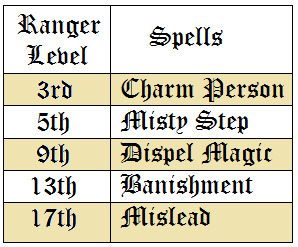
3rd LEVEL – CUNNING WILL
Your experience with the fey has guarded your mind and sharpened your tongue. You have advantage on saving throws against being charmed or frightened. In addition, you gain proficiency in one of the following skills of your choice: Deception, Performance, or Persuasion.
3rd LEVEL – DREADFUL STRIKES
You augment your attacks with mind-scarring magic, drawn from the gloomy hollows of the unseelie fey. You gain a bonus action that you can use to imbue the weapon, or weapons, you’re currently holding with magic. Until the end of the turn, the weapons are magical, and they deal an extra 1d6 psychic damage on a hit. A creature can take this extra damage only once per turn. When you engage in two-weapon fighting, you can imbue your weapons as part of the same bonus action you use to make the attack.
7th LEVEL – BLESSINGS OF THE COURTS
You have learned eerie techniques from both the Gloaming Court and the Summer Court of the Feywild. Once during each of your turns, when you hit a creature with a weapon attack, you can expend a spell slot to deal extra psychic damage. The extra damage is 3d6 psychic damage and the creature must succeed on a Wisdom saving throw against your spell save DC or be frightened of you until the end of your next turn. In addition, whenever you make a Charisma check, you gain a bonus to the check equal to your Wisdom modifier.
11th LEVEL – BEGUILING TWIST
You learn how to manipulate mind-altering magic, channelling it from your allies toward others. Whenever a creature you can see within 120 feet of you succeeds on a saving throw against being charmed or frightened, you can use your reaction to force a different creature you can see within 120 feet of you to succeed on a Wisdom saving throw against your spell save DC or suffer your choice of one of the following effects:
The creature is charmed or frightened by you (your choice) for 1 minute. The creature can repeat the saving throw at the end of each of its turns, ending the effect on itself on a successful save.
The creature takes 3d10 psychic damage.
15th LEVEL – MISTY PRESENCE
You can magically remove yourself from one creature’s perception: you gain a bonus action that you can use to force a creature you can see within 30 feet of you to make a Wisdom saving throw against your spell save DC. On a failed save, the target can’t see or hear you for 24 hours. The target can repeat the saving throw at the end of any turn during which you hit it with an attack roll, forced it to make a saving throw, or dealt damage to it. The effect ends early if you use this bonus action again. On a successful save, the target is immune to this feature for 7 days. Once you’ve used this bonus action, you can’t use it again until you finish a long rest or until you expend a spell slot of 4th level or higher to use it again.
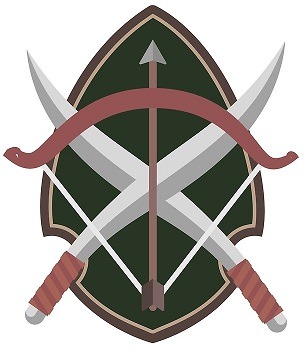
HUNTER
Emulating the Hunter archetype means accepting your place as a bulwark between civilization and the terrors of the wilderness. As you walk the Hunter’s path, you learn specialized techniques for fighting the threats you face, from rampaging ogres and hordes of orcs to towering giants and terrifying dragons.
3rd LEVEL – HUNTER’S PREY
At 3rd level, you gain one of the following features of your choice.
Colossus Slayer
Your tenacity can wear down the most potent foes. When you hit a creature with a weapon attack, the creature takes an extra 1d8 damage if it’s below its hit point maximum. You can deal this extra damage only once per turn.
Giant Killer
When a Large or larger creature within 5 feet of you hits or misses you with an attack, you can use your reaction to attack that creature immediately after its attack, provided that you can see the creature.
Horde Breaker
Once on each of your turns when you make a weapon attack, you can make another attack with the same weapon against a different creature that is within 5 feet of the original target and within range of your weapon.
7th LEVEL – DEFENSIVE TACTICS
At 7th level, you gain one of the following features of your choice.
Escape the Horde
Opportunity attacks against you are made with disadvantage.
Multiattack Defence
When a creature hits you with an attack, you gain a +4 bonus to AC against all subsequent attacks made by that creature for the rest of the turn.
Steel Will
You have advantage on saving throws against being frightened.
11th LEVEL - MULTIATTACK
At 11th level, you gain one of the following features of your choice.
Volley
You can use your action to make a ranged attack against any number of creatures within 10 feet of a point you can see within your weapon’s range. You must have ammunition for each target, as normal, and you make a separate attack roll for each target.
Whirlwind Attack
You can use your action to make a melee attack against any number of creatures within 5 feet of you, with a separate attack roll for each target.
15th LEVEL – SUPERIOR HUNTER’S DEFENCE
At 15th level, you gain one of the following features of your choice.
Evasion
When you are subjected to an effect, such as a red dragon’s fiery breath or a lightning bolt spell, that allows you to make a Dexterity saving throw to take only half damage, you instead take no damage if you succeed on the saving throw, and only half damage if you fail.
Stand Against the Tide
When a hostile creature misses you with a melee attack, you can use your reaction to force that creature to repeat the same attack against another creature (other than itself) of your choice.
Uncanny Dodge
When an attacker that you can see hits you with an attack, you can use your reaction to halve the attack’s damage against you.
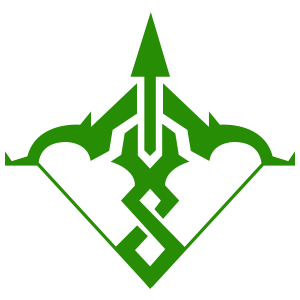
SWARMKEEPER
Feeling a deep connection to the world around them, some rangers reach out through their magical connection to nature and gather a host of fey spirits, which take the form of swarming beasts—be they buzzing insects, fluttering birds, slippery squids, or otherwise. The swarm becomes a potent force in battle, as well as helpful—if potentially disturbing—company for the ranger. Some Swarmkeepers are outcasts or hermits, keeping to themselves and their attendant swarms rather than dealing with the discomfort of others. Other Swarmkeepers enjoy building vibrant communities that work for the mutual benefit of all those they consider part of their swarm.
SWARMKEEPER MAGIC
You learn the mage hand cantrip if you don’t already know it. When you cast it, the hand takes the form of swarming nature spirits. You also learn an additional spell when you reach certain levels in this class, as shown in the Swarmkeeper Spells table. These spells count as ranger spells for you, but don’t count against the number of ranger spells you know.
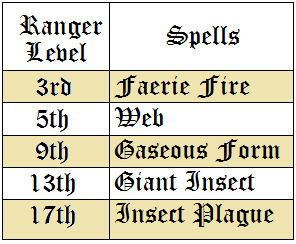
3rd LEVEL – GATHERED SWARM
You magically attract a swarm of fey spirits that look like Tiny beasts of your choice. The swarm remains in your space, crawling on you or through your clothing, or flying and skittering immediately around you within your space. As a bonus action, you can agitate the swarm for 1 minute. For the duration, some of the swarm clings to your weapons or follows your strikes when you attack: once during each of your turns when you hit a creature with a weapon attack, you can deal an extra 1d6 force damage to that creature, and the swarm moves the creature up to 5 feet toward you or away from you (your choice). At 11th level, the extra damage increases to 2d6. You can use this feature a number of times equal to your Wisdom modifier (minimum of once), and you regain all expended uses when you finish a long rest.
7th LEVEL – WRITHING TIDE
You can condense part of your swarm into a focused mass that lifts or sweeps you along. Whenever you activate your Gathered Swarm feature, choose one of the following additional benefits:
Your walking speed increases by 10 feet, and you can take the Disengage action as a bonus action.
You gain a climb speed equal to your walking speed. You can climb difficult surfaces, including upside down on ceilings, without making an ability check.
You gain a flying speed of 10 feet and can hover.
11th LEVEL – SCUTTLING EYES
As an action, you can magically form one of the spirits of your swarm into the shape of a Tiny beast of your choice. The transformation lasts for 1 hour, at which point the spirit disappears. For the duration, the spirit has a speed of 40 feet, which it can use to walk, climb, fly, or swim. The spirit has your senses and telepathically relays what it sees and hears to you. During your turn, you can speak through the spirit, telepathically command it to move, and it can Hide using your bonus to Dexterity (Stealth) checks. The spirit has AC 18. If it takes damage, you must succeed on a Wisdom saving throw (DC equal to 10, or half the damage dealt, whichever is higher) or the spirit disappears. As an action, you can dismiss the spirit early. If you do, you can magically teleport to an unoccupied space within 5 feet of where the spirit disappeared. Once you use this feature, you can’t do so again until you finish a long rest. You can also use it again by expending a spell slot of 3rd level or higher.
15th LEVEL – STORM OF MINIONS
Your swarm can expel a seething storm of spirits that drains life from others. As an action, you create a magical sphere filled with an enraged swarm centred on a point you can see within 120 feet of you. The sphere has a 10-foot-radius and lasts for 1 minute. The sphere is difficult terrain for creatures other than you. A creature other than you that starts its turn in the sphere’s area must make a Constitution saving throw against your spell save DC. On a failed save, the creature takes 2d8 necrotic damage and is blinded until the start of its next turn. On a successful save, it takes half as much damage and isn’t blinded. At the start of your turn, if any number of Small or larger creatures took necrotic damage from the swarm, you regain 1d8 hit points. On subsequent turns, you can use a bonus action to move the sphere up to 30 feet. When you activate this feature, you can choose any number of creatures you can see to be unaffected by it. Once you use this feature, you can’t do so again until you finish a long rest. You can also use it again by expending a spell slot of 4th level or higher.
1 note
·
View note
Text
Paladin

Whatever their origin and their mission, paladins are united by their oaths to stand against the forces of evil. Whether sworn before a god’s altar and the witness of a priest, in a sacred glade before nature spirits and fey beings, or in a moment of desperation and grief with the dead as the only witness, a paladin’s oath is a powerful bond. It is a source of power that turns a devout warrior into a blessed champion.
A paladin swears to uphold justice and righteousness, to stand with the good things of the world against the encroaching darkness, and to hunt the forces of evil wherever they lurk. Different paladins focus on various aspects of the cause of righteousness, but all are bound by the oaths that grant them power to do their sacred work. Although many paladins are devoted to gods of good, a paladin’s power comes as much from a commitment to justice itself as it does from a god. Paladins train for years to learn the skills of combat, mastering a variety of weapons and armour. Even so, their martial skills are secondary to the magical power they wield: power to heal the sick and injured, to smite the wicked and the undead, and to protect the innocent and those who join them in the fight for justice.
Almost by definition, the life of a paladin is an adventuring life. Unless a lasting injury has taken him or her away from adventuring for a time, every paladin lives on the front lines of the cosmic struggle against evil. Fighters are rare enough among the ranks of the militias and armies of the world, but even fewer people can claim the true calling of a paladin. When they do receive the call, these warriors turn from their former occupations and take up arms to fight evil. Sometimes their oaths lead them into the service of the crown as leaders of elite groups of knights, but even then their loyalty is first to the cause of righteousness, not to crown and country. Adventuring paladins take their work seriously. A delve into an ancient ruin or dusty crypt can be a quest driven by a higher purpose than the acquisition of treasure. Evil lurks in dungeons and primeval forests, and even the smallest victory against it can tilt the cosmic balance away from oblivion.
The most important aspect of a paladin character is the nature of his or her holy quest. Although the class features related to your oath don’t appear until you reach 3rd level, plan ahead for that choice by reading the oath descriptions at the end of the class. Are you a devoted servant of good, loyal to the gods of justice and honour, a holy knight in shining armour. venturing forth to smite evil? Are you a glorious champion of the light, cherishing everything beautiful that stands against the shadow, a knight whose oath descends from traditions older than many of the gods? Or are you an embittered loner sworn to take vengeance on those who have done great evil, sent as an angel of death by the gods or driven by your need for revenge? The Gods of the Multiverse section lists many deities worshipped by paladins throughout the multiverse, such as Torm, Tyr, Heironeous, Paladine, Kiri-Jolith, Dol Arrah, the Silver Flame, Bahamut, Athena, Re-Horakhty, and Heimdall. How did you experience your call to serve as a paladin? Did you hear a whisper from an unseen god or angel while you were at prayer? Did another paladin sense the potential within you and decide to train you as a squire? Or did some terrible event—the destruction of your home, perhaps—drive you to your quests? Perhaps you stumbled into a sacred grove or a hidden elven enclave and found yourself called to protect all such refuges of goodness and beauty. Or you might have known from your earliest memories that the paladin’s life was your calling, almost as if you had been sent into the world with that purpose stamped on your soul. As guardians against the forces of wickedness, paladins are rarely of any evil alignment. Most of them walk the paths of charity and justice. Consider how your alignment colours the way you pursue your holy quest and the manner in which you conduct yourself before gods and mortals. Your oath and alignment might be in harmony, or your oath might represent standards of behaviour that you have not yet attained.
A paladin tries to hold to the highest standards of conduct, but even the most virtuous paladin is fallible. Sometimes the right path proves too demanding, sometimes a situation calls for the lesser of two evils, and sometimes the heat of emotion causes a paladin to transgress his or her oath. A paladin who has broken a vow typically seeks absolution from a cleric who shares his or her faith or from another paladin of the same order. The paladin might spend an all-night vigil in prayer as a sign of penitence, or undertake a fast or similar act of self-denial. After a rite of confession and forgiveness, the paladin starts fresh. If a paladin wilfully violates his or her oath and shows no sign of repentance, the consequences can be more serious. At the DM’s discretion, an impenitent paladin might be forced to abandon this class and adopt another, or perhaps to take the Oathbreaker paladin option that appears in the Dungeon Master’s Guide.
HIT POINTS: 1d10 Per Paladin Level
HIT POINTS 1st LEVEL: 1d10 + CON
PROFICIENCIES
ARMOUR: All armour; Shields
WEAPONS: Simple weapons, Martial weapons
TOOLS: None
SAVING THROWS: Wisdom, Charisma
SKILLS: Athletics, Insight, Intimidation, Medicine, Persuasion, and Religion (Choose 2)
STARTING EQUIPMENT
1. A martial weapon and shield OR Two martial weapons
2. Five javelins OR Any simple weapon
3. A priest’s pack OR An explorer’s pack
4. Chain mail AND A holy symbol
FEATURES

DIVINE SENSE
The presence of strong evil registers on your senses like a noxious odour, and powerful good rings like heavenly music in your ears. As an action, you can open your awareness to detect such forces. Until the end of your next turn, you know the location of any celestial, fiend, or undead within 60 feet of you that is not behind total cover. You know the type (celestial, fiend, or undead) of any being whose presence you sense, but not its identity (the vampire Count Strahd von Zarovich, for instance). Within the same radius, you also detect the presence of any place or object that has been consecrated or desecrated, as with the hallow spell. You can use this feature a number of times equal to 1 + your Charisma modifier. When you finish a long rest, you regain all expended uses.
LAY ON HANDS
Your blessed touch can heal wounds. You have a pool of healing power that replenishes when you take a long rest. With that pool, you can restore a total number of hit points equal to your paladin level × 5. As an action, you can touch a creature and draw power from the pool to restore a number of hit points to that creature, up to the maximum amount remaining in your pool. Alternatively, you can expend 5 hit points from your pool of healing to cure the target of one disease or neutralize one poison affecting it. You can cure multiple diseases and neutralize multiple poisons with a single use of Lay on Hands, expending hit points separately for each one. This feature has no effect on undead and constructs.
FIGHTING STYLE
At 2nd level, you adopt a style of fighting as your speciality. Choose one of the following options. You can’t take a Fighting Style option more than once, even if you later get to choose again.
Defence
While you are wearing armour., you gain a +1 bonus to AC.
Duelling
When you are wielding a melee weapon in one hand and no other weapons, you gain a +2 bonus to damage rolls with that weapon.
Great Weapon Fighting
When you roll a 1 or 2 on a damage die for an attack you make with a melee weapon that you are wielding with two hands, you can reroll the die and must use the new roll. The weapon must have the two-handed or versatile property for you to gain this benefit.
Protection
When a creature you can see attacks a target other than you that is within 5 feet of you, you can use your reaction to impose disadvantage on the attack roll. You must be wielding a shield.
SPELLCASTING
By 2nd level, you have learned to draw on divine magic through meditation and prayer to cast spells as a cleric does. See Spells Rules for the general rules of spellcasting and the Spells Listing for the paladin spell list.
Preparing and Casting Spells
The Paladin table shows how many spell slots you have to cast your paladin spells. To cast one of your paladin spells of 1st level or higher, you must expend a slot of the spell’s level or higher. You regain all expended spell slots when you finish a long rest. You prepare the list of paladin spells that are available for you to cast, choosing from the paladin spell list. When you do so, choose a number of paladin spells equal to your Charisma modifier + half your paladin level, rounded down (minimum of one spell). The spells must be of a level for which you have spell slots. For example, if you are a 5th-level paladin, you have four 1st-level and two 2nd-level spell slots. With a Charisma of 14, your list of prepared spells can include four spells of 1st or 2nd level, in any combination. If you prepare the 1st-level spell cure wounds, you can cast it using a 1st-level or a 2nd-level slot. Casting the spell doesn’t remove it from your list of prepared spells. You can change your list of prepared spells when you finish a long rest. Preparing a new list of paladin spells requires time spent in prayer and meditation: at least 1 minute per spell level for each spell on your list.
Spellcasting Ability
Charisma is your spellcasting ability for your paladin spells, since their power derives from the strength of your convictions. You use your Charisma whenever a spell refers to your spellcasting ability. In addition, you use your Charisma modifier when setting the saving throw DC for a paladin spell you cast and when making an attack roll with one.
Spell save DC = 8 + your proficiency bonus + your Charisma modifier
Spell attack modifier = your proficiency bonus + your Charisma modifier
Spellcasting Focus
You can use a holy symbol (see the Adventuring Gear section) as a spellcasting focus for your paladin spells.
DIVINE SMITE
Starting at 2nd level, when you hit a creature with a melee weapon attack, you can expend one spell slot to deal radiant damage to the target, in addition to the weapon’s damage. The extra damage is 2d8 for a 1st-level spell slot, plus 1d8 for each spell level higher than 1st, to a maximum of 5d8. The damage increases by 1d8 if the target is an undead or a fiend, to a maximum of 6d8.
DIVINE HEALTH
By 3rd level, the divine magic flowing through you makes you immune to disease.
SACRED OATH
When you reach 3rd level, you swear the oath that binds you as a paladin forever. Up to this time you have been in a preparatory stage, committed to the path but not yet sworn to it. Now you choose the Oath of Devotion detailed at the end of the class description or one from another source. Your choice grants you features at 3rd level and again at 7th, 15th, and 20th level. Those features include oath spells and the Channel Divinity feature.
OATH SPELLS
Each oath has a list of associated spells. You gain access to these spells at the levels specified in the oath description. Once you gain access to an oath spell, you always have it prepared. Oath spells don’t count against the number of spells you can prepare each day. If you gain an oath spell that doesn’t appear on the paladin spell list, the spell is nonetheless a paladin spell for you.
CHANNEL DIVINITY
Your oath allows you to channel divine energy to fuel magical effects. Each Channel Divinity option provided by your oath explains how to use it. When you use your Channel Divinity, you choose which option to use. You must then finish a short or long rest to use your Channel Divinity again. Some Channel Divinity effects require saving throws. When you use such an effect from this class, the DC equals your paladin spell save DC.
ABILITY SCORE IMPROVEMENT
When you reach 4th level, and again at 8th, 12th, 16th, and 19th level, you can increase one ability score of your choice by 2, or you can increase two ability scores of your choice by 1. As normal, you can’t increase an ability score above 20 using this feature.
EXTRA ATTACK
Beginning at 5th level, you can attack twice, instead of once, whenever you take the Attack action on your turn.
AURA OF PROTECTION
Starting at 6th level, whenever you or a friendly creature within 10 feet of you must make a saving throw, the creature gains a bonus to the saving throw equal to your Charisma modifier (with a minimum bonus of +1). You must be conscious to grant this bonus. At 18th level, the range of this aura increases to 30 feet.
AURA OF COURAGE
Starting at 10th level, you and friendly creatures within 10 feet of you can’t be frightened while you are conscious. At 18th level, the range of this aura increases to 30 feet.
IMPROVED DIVINE SMITE
By 11th level, you are so suffused with righteous might that all your melee weapon strikes carry divine power with them. Whenever you hit a creature with a melee weapon, the creature takes an extra 1d8 radiant damage.
CLEANSING TOUCH
Beginning at 14th level, you can use your action to end one spell on yourself or on one willing creature that you touch. You can use this feature a number of times equal to your Charisma modifier (a minimum of once). You regain expended uses when you finish a long rest.
AURA IMPROVEMENTS
At 18th level, the range of your auras increase to 30 feet.

SACRED OATHS
Becoming a paladin involves taking vows that commit the paladin to the cause of righteousness, an active path of fighting wickedness. The final oath, taken when he or she reaches 3rd level, is the culmination of all the paladin’s training. Some characters with this class don’t consider themselves true paladins until they have reached 3rd level and made this oath. For others, the actual swearing of the oath is a formality, an official stamp on what has always been true in the paladin’s heart.
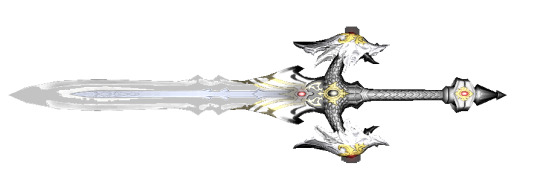
OATH OF DEVOTION
The Oath of Devotion binds a paladin to the loftiest ideals of justice, virtue, and order. Sometimes called cavaliers, white knights, or holy warriors, these paladins meet the ideal of the knight in shining armour., acting with honour in pursuit of justice and the greater good. They hold themselves to the highest standards of conduct, and some, for better or worse, hold the rest of the world to the same standards. Many who swear this oath are devoted to gods of law and good and use their gods’ tenets as the measure of their devotion. They hold angels—the perfect servants of good—as their ideals, and incorporate images of angelic wings into their helmets or coats of arms.
TENETS OF DEVOTION
Though the exact words and strictures of the Oath of Devotion vary, paladins of this oath share these tenets.
Honesty. Don’t lie or cheat. Let your word be your promise.
Courage. Never fear to act, though caution is wise.
Compassion. Aid others, protect the weak, and punish those who threaten them. Show mercy to your foes, but temper it with wisdom.
Honour. Treat others with fairness, and let your honourable deeds be an example to them. Do as much good as possible while causing the least amount of harm.
Duty. Be responsible for your actions and their consequences, protect those entrusted to your care, and obey those who have just authority over you.
OATH OF DEVOTION SPELLS
You gain oath spells at the paladin levels listed.
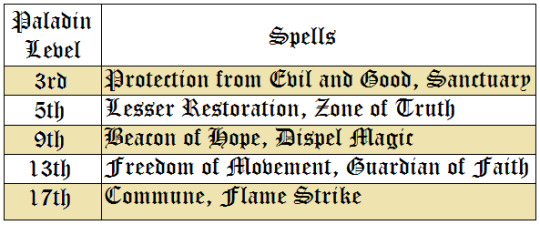
3rd LEVEL – CHANNEL DIVINITY
When you take this oath, you gain the following two Channel Divinity options.
Sacred Weapon. As an action, you can imbue one weapon that you are holding with positive energy, using your Channel Divinity. For 1 minute, you add your Charisma modifier to attack rolls made with that weapon (with a minimum bonus of +1). The weapon also emits bright light in a 20-foot radius and dim light 20 feet beyond that. If the weapon is not already magical, it becomes magical for the duration. You can end this effect on your turn as part of any other action. If you are no longer holding or carrying this weapon, or if you fall unconscious, this effect ends.
Turn the Unholy. As an action, you present your holy symbol and speak a prayer censuring fiends and undead, using your Channel Divinity. Each fiend or undead that can see or hear you within 30 feet of you must make a Wisdom saving throw. If the creature fails its saving throw, it is turned for 1 minute or until it takes damage. A turned creature must spend its turns trying to move as far away from you as it can, and it can’t willingly move to a space within 30 feet of you. It also can’t take reactions. For its action, it can use only the Dash action or try to escape from an effect that prevents it from moving. If there’s nowhere to move, the creature can use the Dodge action.
7th LEVEL – AURA OF DEVOTION
You and friendly creatures within 10 feet of you can’t be charmed while you are conscious. At 18th level, the range of this aura increases to 30 feet.
15th LEVEL – PURITY OF SPIRIT
You are always under the effects of a protection from evil and good spell.
20th LEVEL – HOLY NIMBUS
As an action, you can emanate an aura of sunlight. For 1 minute, bright light shines from you in a 30-foot radius, and dim light shines 30 feet beyond that. Whenever an enemy creature starts its turn in the bright light, the creature takes 10 radiant damage. In addition, for the duration, you have advantage on saving throws against spells cast by fiends or undead. Once you use this feature, you can’t use it again until you finish a long rest.
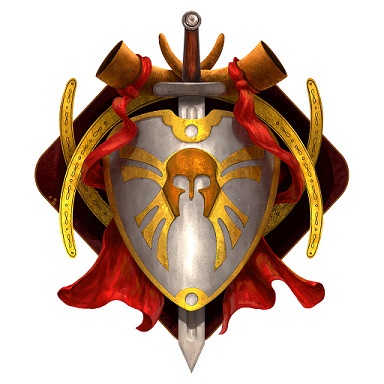
OATH OF HEROISM
The Oath of Heroism is an affirmation of a destined path, one laid out for you by divine hands. For whatever reason, a god or a group of gods has included you in their machinations. You are not a reluctant hero, but one who fully embraces the idea that great deeds are yours to achieve. You train diligently, sculpting your body and refining your skills so you’re ready when destiny calls.
TENETS OF HEROISM
The tenets of the Oath of Heroism reflect a paladin’s commitment to fulfilling their calling as a hero worthy of legend.
Actions over Words. Strive to be known by deeds not words.
Challenges Are but Tests. Every hardship serves to challenge your abilities and harden your resolve.
Embrace Destiny. You didn’t choose this path, but it’s yours to walk. And it will carry you into legend.
Hone the Body. Like raw stone, your body must be worked so its potential can be realized.
OATH SPELLS
You gain oath spells at the paladin levels listed in the Oath of Heroism Spells table. See the Sacred Oath class feature for how oath spells work.

3rd LEVEL – CHANNEL DIVINITY
You gain the following two Channel Divinity options. See the Sacred Oath class feature for how Channel Divinity works.
Peerless Athlete. You can use your Channel Divinity to augment your athleticism with divine favour. As a bonus action, you gain advantage on all Strength (Athletics) and Dexterity (Acrobatics) checks for the next 10 minutes.
Legendary Strike. You can use your Channel Divinity as a bonus action to guide your attacks: for 1 minute, your weapon attacks score a critical hit on a roll of 19 or 20 on the d20.
7th LEVEL – MIGHTY DEED
Your actions on the battlefield can supernaturally bolster your allies and demoralize your enemies. Whenever you score a critical hit or reduce a creature to 0 hit points, you can choose one or more creatures that you can see within 30 feet of you, up to a number equal to your Charisma modifier (minimum of one creature). All the chosen creatures are affected by one of the following effects of your choice:
The creature gains temporary hit points equal to 1d6 + your Charisma modifier (minimum of 1 temporary hit point).
The creature must succeed on a Wisdom saving throw against your spell save DC or be frightened of you until the start of your next turn.
Once you use this feature, you can’t use it again until the start of your next turn.
15th LEVEL – GLORIOUS DEFENCE
Your blessed glory on the battlefield can misdirect an attack. When a creature you can see hits you with an attack roll, you can use your reaction to gain a bonus to AC against that attack, potentially causing it to miss you. The bonus equals your Charisma modifier (minimum of +1). If the attack misses, you can make one weapon attack against the attacker as part of this reaction.
20th LEVEL – LIVING MYTH
You can now empower yourself with the legends—whether true or exaggerated—told of your great deeds. As a bonus action, you gain the following benefits for 10 minutes:
You are blessed with otherworldly comeliness, gaining advantage on all Charisma checks.
Once on each of your turns when you make a weapon attack and miss, you can cause that attack to hit instead.
If you fail a saving throw, you can use your reaction to succeed instead.
Once you use this feature, you can’t use it again until you finish a long rest.
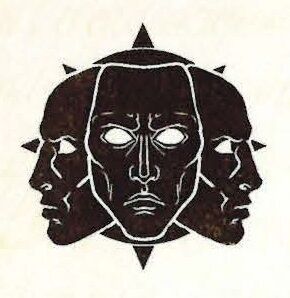
OATH OF THE WATCHERS
Paladins who vow the Oath of the Watchers seek to protect the mortal realm from the predations of extraplanar creatures, many of which can lay waste to mortal soldiers. Thus, the Watchers hone their minds, spirits, and bodies to be the ultimate weapons against such threats. Paladins who follow the Watchers’ oath are ever vigilant in spotting the influence of extraplanar forces, often establishing a network of spies and informants to gather information on suspected cults. To a Watcher, keeping a healthy suspicion and awareness about one’s surroundings is as natural as wearing armour. in battle.
TENETS OF THE WATCHERS
A paladin who assumes the Oath of the Watchers swears to safeguard the mortal realm from otherworldly threats.
Vigilance. The threats you face are cunning, powerful, and subversive. Be ever alert for their corruption.
Loyalty. Never accept gifts or favours from fiends or those who truck with them. Stay true to your order, your comrades, and your duty.
Discipline. You are the shield against the endless terrors that lie beyond the stars. Your blade must be forever sharp and your mind keen to survive what lies beyond.
OATH SPELLS
You gain oath spells at the paladin levels listed in the Oath of the Watchers table. See the Sacred Oath class feature for how oath spells work.
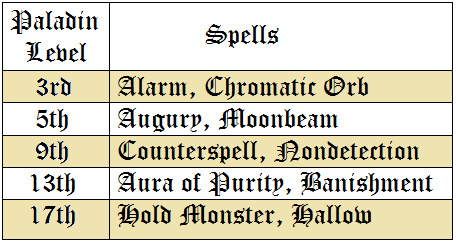
3rd LEVEL – CHANNEL DIVINITY
You gain the following Channel Divinity options. See the Sacred Oath class feature for how Channel Divinity works.
Watcher’s Will. You can use your Channel Divinity to invest your presence with the warding power of your faith. As an action, you can choose a number of creatures you can see within 30 feet of you, up to a number equal to your Charisma modifier (minimum of one creature). For 1 minute, all the chosen creatures have advantage on Intelligence, Wisdom, and Charisma saving throws.
Abjure the Extraplanar. You can use your Channel Divinity to castigate unworldly beings. As an action, you present your holy symbol and each elemental, fey, fiend, or aberration within 30 feet of you that can hear you must make a Wisdom saving throw. On a failed save, the creature is turned for 1 minute or until it takes damage. A turned creature must spend its turns trying to move as far away from you as it can, and it can’t willingly move to a space within 30 feet of you. For its action, it can use only the Dash action or try to escape from an effect that prevents it from moving. If there’s nowhere to move, the creature can use the Dodge action.
7th LEVEL – AURA OF THE SENTINEL
You emit an aura of alertness while you aren’t incapacitated. When you and any creature of your choice within 10 feet of you rolls initiative, you each gain a bonus to initiative equal to your Charisma modifier (minimum of +1). At 18th level, the range of this aura increases to 30 feet.
15th LEVEL – VIGILANT REBUKE
You’ve learned how to magically chastise anyone who dares cast unwanted spells at you and your wards. Whenever you or a creature you can see within 30 feet of you succeeds on a saving throw against a spell, you can use your reaction to deal 2d8 + your Charisma modifier force damage to the spellcaster.
20th LEVEL – MORTAL BULWARK
You manifest a spark of your deity’s power in defence of your sacred oath. As a bonus action, you gain the following benefits for 1 minute:
You gain truesight in a 120-foot radius.
You have advantage on attack rolls against elementals, fey, fiends, and aberrations.
When you hit a creature with an attack and deal damage to it, you can also force it to make a Charisma saving throw. On a failed save, the creature is magically banished to its native plane of existence if it’s currently not there. On a successful save, the creature can’t be banished by this feature for 24 hours.
Once you use this bonus action, you can’t use it again until you finish a long rest.
111 notes
·
View notes
Text
Races
Dragonborn
https://burkesguidetodnd.tumblr.com/post/190789371206/dragonborn
Dwarf
https://burkesguidetodnd.tumblr.com/post/190874211531/dwarf
Elf
https://burkesguidetodnd.tumblr.com/post/190981089196/elf
Gnome
https://burkesguidetodnd.tumblr.com/post/190981222816/gnome
Half Elf
https://burkesguidetodnd.tumblr.com/post/190981312366/half-elf
Halfling
https://burkesguidetodnd.tumblr.com/post/190981411466/halfling
Half Orc
https://burkesguidetodnd.tumblr.com/post/190981493591/half-orc
Human
https://burkesguidetodnd.tumblr.com/post/190981548831/human
Tiefling
https://burkesguidetodnd.tumblr.com/post/190981616416/tiefling
3 notes
·
View notes
Text
Paladin
https://burkesguidetodnd.tumblr.com/post/612575408155754496/paladin
Ranger
https://burkesguidetodnd.tumblr.com/post/612582247426621440/ranger
Classes
Barbarian
https://burkesguidetodnd.tumblr.com/post/611519854950891520/barbarian
Bard
https://burkesguidetodnd.tumblr.com/post/611519867805401088/bard
Cleric
https://burkesguidetodnd.tumblr.com/post/611519872533397504/cleric
Druid
https://burkesguidetodnd.tumblr.com/post/612068013457489920/druid
Fighter
https://burkesguidetodnd.tumblr.com/post/612057256083800064/fighter
Monk
https://burkesguidetodnd.tumblr.com/post/612066775633461248/monk
5 notes
·
View notes
Text
Druid
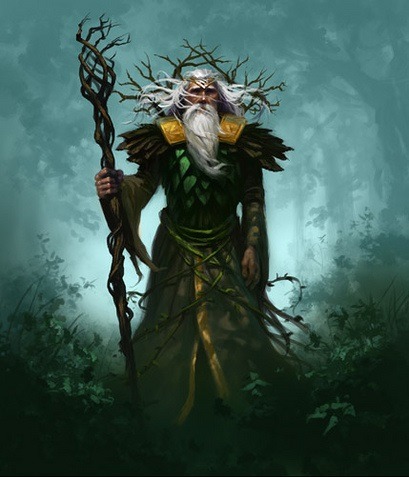
Whether calling on the elemental forces of nature or emulating the creatures of the animal world, druids are an embodiment of nature’s resilience, cunning, and fury. They claim no mastery over nature. Instead, they see themselves as extensions of nature’s indomitable will.
Druids revere nature above all, gaining their spells and other magical powers either from the force of nature itself or from a nature deity. Many druids pursue a mystic spirituality of transcendent union with nature rather than devotion to a divine entity, while others serve gods of wild nature, animals, or elemental forces. The ancient Druidic traditions are sometimes called the Old Faith, in contrast to the worship of gods in temples and shrines. Druid spells are oriented toward nature and animals—the power of tooth and claw, of sun and moon, of fire and storm. Druids also gain the ability to take on animal forms, and some druids make a particular study of this practice, even to the point where they prefer animal form to their natural form.
For druids, nature exists in a precarious balance. The four elements that make up a world—air, earth, fire, and water—must remain in equilibrium. If one element were to gain power over the others, the world could be destroyed, drawn into one of the elemental planes and broken apart into its component elements. Thus, druids oppose cults of Elemental Evil and others who promote one element to the exclusion of others. Druids are also concerned with the delicate ecological balance that sustains plant and animal life, and the need for civilized folk to live in harmony with nature, not in opposition to it. Druids accept that which is cruel in nature, and they hate that which is unnatural, including aberrations (such as beholders and mind flayers) and undead (such as zombies and vampires). Druids sometimes lead raids against such creatures, especially when the monsters encroach on the druids’ territory. Druids are often found guarding sacred sites or watching over regions of unspoiled nature. But when a significant danger arises, threatening nature’s balance or the lands they protect, druids take on a more active role in combating the threat, as adventurers.
When making a druid, consider why your character has such a close bond with nature. Perhaps your character lives in a society where the Old Faith still thrives, or was raised by a druid after being abandoned in the depths of a forest. Perhaps your character had a dramatic encounter with the spirits of nature, coming face to face with a giant eagle or dire wolf and surviving the experience. Maybe your character was born during an epic storm or a volcanic eruption, which was interpreted as a sign that becoming a druid was part of your character’s destiny. Have you always been an adventurer as part of your Druidic calling, or did you first spend time as a caretaker of a sacred grove or spring? Perhaps your homeland was befouled by evil, and you took up an adventuring life in hopes of finding a new home or purpose.
A druid holds certain plants to be sacred, particularly alder, ash, birch, elder, hazel, holly, juniper, mistletoe, oak, rowan, willow, and yew. Druids often use such plants as part of a spellcasting focus, incorporating lengths of oak or yew or sprigs of mistletoe. Similarly, a druid uses such woods to make other objects, such as weapons and shields. Yew is associated with death and rebirth, so weapon handles for scimitars or sickles might be fashioned from it. Ash is associated with life and oak with strength. These woods make excellent hafts or whole weapons, such as clubs or quarterstaffs, as well as shields. Alder is associated with air, and it might be used for thrown weapons, such as darts or javelins. Druids from regions that lack the plants described here have chosen other plants to take on similar uses. For instance, a druid of a desert region might value the yucca tree and cactus plants.
Some druids venerate the forces of nature themselves, but most druids are devoted to one of the many nature deities worshipped in the multiverse. The worship of these deities is often considered a more ancient tradition than the faiths of clerics and urbanized peoples. In fact, in the world of Greyhawk, the Druidic faith is called the Old Faith, and it claims many adherents among farmers, foresters, fishers, and others who live closely with nature. This tradition includes the worship of Nature as a primal force beyond personification, but also encompasses the worship of Beory, the Oerth Mother, as well as devotees of Obad-Hai, Ehlonna, and Ulaa. In the worlds of Greyhawk and the Forgotten Realms, Druidic circles are not usually connected to the faith of a single nature deity. Any given circle in the Forgotten Realms, for example, might include druids who revere Silvanus, Mielikki, Eldath, Chauntea, or even the harsh Gods of Fury: Talos, Malar, Auril, and Umberlee. These nature gods are often called the First Circle, the first among the druids, and most druids count them all (even the violent ones) as worthy of veneration. The druids of Eberron hold animistic beliefs completely unconnected to the Sovereign Host, the Dark Six, or any of the other religions of the world. They believe that every living thing and every natural phenomenon—sun, moon, wind, fire, and the world itself—has a spirit. Their spells, then, are a means to communicate with and command these spirits. Different Druidic sects, though, hold different philosophies about the proper relationship of these spirits to each other and to the forces of civilization. The Ashbound, for example, believe that arcane magic is an abomination against nature, the Children of Winter venerate the forces of death, and the Gatekeepers preserve ancient traditions meant to protect the world from the incursion of aberrations.
HIT POINTS: 1d8 per Druidic level
HIT POINTS AT 1st LEVEL: 1d8 + CON
PROFICIENCIES
ARMOUR: Light, Medium, Shields (But NO metal)
WEAPONS: Clubs, Daggers, Darts, Javelins, Maces, Quarterstaffs, Scimitars, Sickles, Slings, Spears
TOOLS: Herbalism Kit
SKILLS: Arcana, Animal Handling, Insight, Medicine, Nature, Perception, Religion, and Survival (Choose 2)
EQUIPMENT
1. A shield OR Any simple weapon
2. A scimitar OR Any simple melee weapon
3. Leather armour AND An explorer’s Pack AND A Druidic Focus
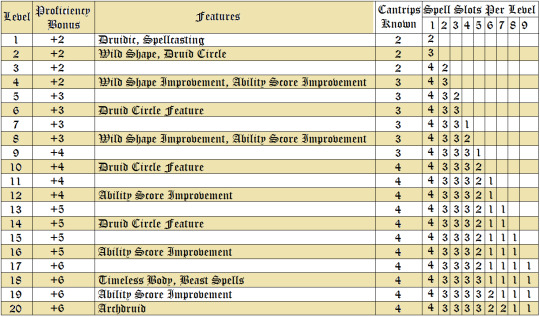
DRUIDIC
You know Druidic, the secret language of druids. You can speak the language and use it to leave hidden messages. You and others who know this language automatically spot such a message. Others spot the message’s presence with a successful DC 15 Wisdom (Perception) check but can’t decipher it without magic.
SPELLCASTING
Drawing on the divine essence of nature itself, you can cast spells to shape that essence to your will. See Spells Rules for the general rules of spellcasting and the Spells Listing for the druid spell list.
Cantrips
At 1st level, you know two cantrips of your choice from the druid spell list. You learn additional druid cantrips of your choice at higher levels, as shown in the Cantrips Known column of the Druid table.
Preparing and Casting Spells
The Druid table shows how many spell slots you have to cast your druid spells of 1st level and higher. To cast one of these druid spells, you must expend a slot of the spell’s level or higher. You regain all expended spell slots when you finish a long rest. You prepare the list of druid spells that are available for you to cast, choosing from the druid spell list. When you do so, choose a number of druid spells equal to your Wisdom modifier + your druid level (minimum of one spell). The spells must be of a level for which you have spell slots. For example, if you are a 3rd-level druid, you have four 1st-level and two 2nd-level spell slots. With a Wisdom of 16, your list of prepared spells can include six spells of 1st or 2nd level, in any combination. If you prepare the 1st-level spell cure wounds, you can cast it using a 1st-level or 2nd-level slot. Casting the spell doesn’t remove it from your list of prepared spells. You can also change your list of prepared spells when you finish a long rest. Preparing a new list of druid spells requires time spent in prayer and meditation: at least 1 minute per spell level for each spell on your list.
Spellcasting Ability
Wisdom is your spellcasting ability for your druid spells, since your magic draws upon your devotion and attunement to nature. You use your Wisdom whenever a spell refers to your spellcasting ability. In addition, you use your Wisdom modifier when setting the saving throw DC for a druid spell you cast and when making an attack roll with one.
Spell save DC = 8 + your proficiency bonus + your Wisdom modifier
Spell attack modifier = your proficiency bonus + your Wisdom modifier
Ritual Casting
You can cast a druid spell as a ritual if that spell has the ritual tag and you have the spell prepared.
Spellcasting Focus
You can use a Druidic focus (see the Adventuring Gear section) as a spellcasting focus for your druid spells.
WILD SHAPE
Starting at 2nd level, you can use your action to magically assume the shape of a beast that you have seen before. You can use this feature twice. You regain expended uses when you finish a short or long rest. Your druid level determines the beasts you can transform into, as shown in the Beast Shapes table. At 2nd level, for example, you can transform into any beast that has a challenge rating of 1/4 or lower that doesn’t have a flying or swimming speed.

You can stay in a beast shape for a number of hours equal to half your druid level (rounded down). You then revert to your normal form unless you expend another use of this feature. You can revert to your normal form earlier by using a bonus action on your turn. You automatically revert if you fall unconscious, drop to 0 hit points, or die. While you are transformed, the following rules apply:
Your game statistics are replaced by the statistics of the beast, but you retain your alignment, personality, and Intelligence, Wisdom, and Charisma scores. You also retain all of your skill and saving throw proficiencies, in addition to gaining those of the creature. If the creature has the same proficiency as you and the bonus in its stat block is higher than yours, use the creature’s bonus instead of yours. If the creature has any legendary or lair actions, you can’t use them.
When you transform, you assume the beast’s hit points and Hit Dice. When you revert to your normal form, you return to the number of hit points you had before you transformed. However, if you revert as a result of dropping to 0 hit points, any excess damage carries over to your normal form. For example, if you take 10 damage in animal form and have only 1 hit point left, you revert and take 9 damage. As long as the excess damage doesn’t reduce your normal form to 0 hit points, you aren’t knocked unconscious.
You can’t cast spells, and your ability to speak or take any action that requires hands is limited to the capabilities of your beast form. Transforming doesn’t break your concentration on a spell you’ve already cast, however, or prevent you from taking actions that are part of a spell, such as call lightning, that you’ve already cast.
You retain the benefit of any features from your class, race, or other source and can use them if the new form is physically capable of doing so. However, you can’t use any of your special senses, such as darkvision, unless your new form also has that sense.
You choose whether your equipment falls to the ground in your space, merges into your new form, or is worn by it. Worn equipment functions as normal, but the DM decides whether it is practical for the new form to wear a piece of equipment, based on the creature’s shape and size. Your equipment doesn’t change size or shape to match the new form, and any equipment that the new form can’t wear must either fall to the ground or merge with it. Equipment that merges with the form has no effect until you leave the form.
DRUID CIRCLE
At 2nd level, you choose to identify with a circle of druids: the Circle of the Land detailed at the end of the class description or one from the Player's Handbook or other sources. Your choice grants you features at 2nd level and again at 6th, 10th, and 14th level.
WILD SHAPE IMPROVEMENT
At 4th level, you can use your action to magically assume the shape of a beast that you have seen before of challenge rating 1/2 or lower that doesn't have a flying speed. You can use this feature twice. You regain expended uses when you finish a short or long rest.
ABILITY SCORE IMPROVEMENT
When you reach 4th level, and again at 8th, 12th, 16th, and 19th level, you can increase one ability score of your choice by 2, or you can increase two ability scores of your choice by 1. As normal, you can’t increase an ability score above 20 using this feature.
WILD SHAPE IMPROVEMENT
At 8th level, you can use your action to magically assume the shape of a beast that you have seen before of challenge rating 1 or lower. You can use this feature twice. You regain expended uses when you finish a short or long rest.
TIMELESS BODY
Starting at 18th level, the primal magic that you wield causes you to age more slowly. For every 10 years that pass, your body ages only 1 year.
BEAST SPELLS
Beginning at 18th level, you can cast many of your druid spells in any shape you assume using Wild Shape. You can perform the somatic and verbal components of a druid spell while in a beast shape, but you aren’t able to provide material components.
ARCH DRUID
At 20th level, you can use your Wild Shape an unlimited number of times. Additionally, you can ignore the verbal and somatic components of your druid spells, as well as any material components that lack a cost and aren’t consumed by a spell. You gain this benefit in both your normal shape and your beast shape from Wild Shape.
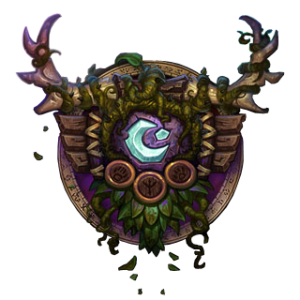
DRUID CIRCLES
Though their organization is invisible to most outsiders, druids are part of a society that spans the land, ignoring political borders. All druids are nominally members of this Druidic society, though some individuals are so isolated that they have never seen any high-ranking members of the society or participated in Druidic gatherings. Druids recognize each other as brothers and sisters. Like creatures of the wilderness, however, druids sometimes compete with or even prey on each other. At a local scale, druids are organized into circles that share certain perspectives on nature, balance, and the way of the druid.

CIRCLE OF THE LAND
The Circle of the Land is made up of mystics and sages who safeguard ancient knowledge and rites through a vast oral tradition. These druids meet within sacred circles of trees or standing stones to whisper primal secrets in Druidic. The circle’s wisest members preside as the chief priests of communities that hold to the Old Faith and serve as advisors to the rulers of those folk. As a member of this circle, your magic is influenced by the land where you were initiated into the circle’s mysterious rites.
2nd LEVEL – BONUS CANTRIP
When you choose this circle at 2nd level, you learn one additional druid cantrip of your choice.
2nd LEVEL – NATURAL RECOVERY
Starting at 2nd level, you can regain some of your magical energy by sitting in meditation and communing with nature. During a short rest, you choose expended spell slots to recover. The spell slots can have a combined level that is equal to or less than half your druid level (rounded up), and none of the slots can be 6th level or higher. You can’t use this feature again until you finish a long rest. For example, when you are a 4th-level druid, you can recover up to two levels worth of spell slots. You can recover either a 2nd-level slot or two 1st-level slots.
3rd LEVEL – CIRCLE SPELLS
Your mystical connection to the land infuses you with the ability to cast certain spells. At 3rd, 5th, 7th, and 9th level you gain access to circle spells connected to the land where you became a druid. Choose that land — arctic, coast, desert, forest, grassland, mountain, swamp, or Underdark — and consult the associated list of spells. Once you gain access to a circle spell, you always have it prepared, and it doesn’t count against the number of spells you can prepare each day. If you gain access to a spell that doesn’t appear on the druid spell list, the spell is nonetheless a druid spell for you.
Arctic Spells

Coast Spells

Desert Spells

Forest Spells

Grassland Spells

Mountain Spells

Swamp Spells

Underdark Spells

6th LEVEL – LAND’S STRIDE
Starting at 6th level, moving through non-magical difficult terrain costs you no extra movement. You can also pass through non-magical plants without being slowed by them and without taking damage from them if they have thorns, spines, or a similar hazard. In addition, you have advantage on saving throws against plants that are magically created or manipulated to impede movement, such those created by the entangle spell.
10th LEVEL – NATURE’S WARD
When you reach 10th level, you can’t be charmed or frightened by elementals or fey, and you are immune to poison and disease.
14th LEVEL – NATURE’S SANCTUARY
When you reach 14th level, creatures of the natural world sense your connection to nature and become hesitant to attack you. When a beast or plant creature attacks you, that creature must make a Wisdom saving throw against your druid spell save DC. On a failed save, the creature must choose a different target, or the attack automatically misses. On a successful save, the creature is immune to this effect for 24 hours. The creature is aware of this effect before it makes its attack against you.
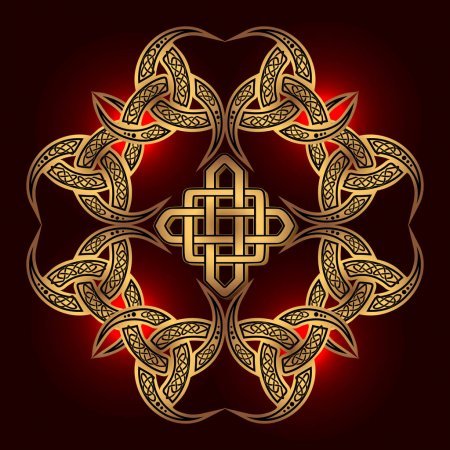
CIRCLE OF THE STARS
An ancient lineage, the Circle of Stars allows druids to draw on the power of starlight. These druids have tracked heavenly patterns since time immemorial, discovering secrets hidden amid the constellations. By revealing and understanding these secrets, the Circle of the Stars seeks to harness the powers of the cosmos. Many druids of this circle keep detailed records of the stars and their effects on the world. Some groups document these observations at megalithic sites, which serve as enigmatic libraries of lore. These repositories might take the form of stone circles, pyramids, petroglyphs, and underground temples—any construction durable enough to protect the circle's sacred knowledge even against a great cataclysm.
2nd LEVEL – STAR MAP
You've created a star map as part of your study of the heavens. The map is a Tiny object and can serve as a spellcasting focus for your druid spells. You decide what form the object takes, or you can determine what it is by rolling on the Star Map table.

If you lose your map, you can perform a 1-hour ceremony to magically create a replacement. This ceremony can be performed during a short or long rest, and it destroys the previous map. You can cast the augury and guiding bolt spells without expending a spell slot and without preparing the spell, provided you use the star map as the spellcasting focus. You can cast a spell from the map in this way a number of times equal to your Wisdom modifier (minimum of once), and you regain all expended uses when you finish a long rest.
2nd LEVEL – STARRY FORM
You gain the ability to harness constellations’ power to alter your form. As an action, you can expend a use of your Wild Shape feature to take on a starry form rather than transforming into a beast. While in your starry form, you retain your game statistics, but your body takes on a luminous, star-like quality; your joints glimmer like stars, and glowing lines connect them as on a star chart. This form sheds bright light in a 10-foot radius and dim light for an additional 10 feet. The form lasts for 10 minutes or until you’re incapacitated. Whenever you assume your starry form, choose which of the following constellations glimmers on your body; your choice gives you certain benefits while in the form:
Chalice. A constellation of a life-giving goblet appears on you. Whenever you cast a spell using a spell slot that restores hit points to a creature, you or another creature within 30 feet of you can regain hit points equal to 1d8 + half your level in this class.
Archer. A constellation of an archer appears on you. You gain a bonus action that you can use to make a ranged spell attack, hurling a luminous arrow that targets a creature you can see within 60 feet of you. On a hit, the attack deals radiant damage equal to 1d8 + your Wisdom modifier.
Dragon. A constellation of a wise, ancient dragon appears on you. When you make an Intelligence or a Wisdom check or a Constitution saving throw to maintain concentration on a spell, you can treat a roll of 9 or lower on the d20 as a 10.
6th LEVEL – COSMIC OMEN
You learn to use your star map to divine the will of the cosmos. Whenever you finish a long rest, you can consult your star map for omens. When you do so, roll a d6. You gain one of the following possible omens based on whether you rolled an even number or an odd number on the d6:
Weal (even). Whenever a creature you can see within 30 feet of you makes an attack roll, a saving throw, or an ability check, you can use your reaction to roll a d6 and add the number rolled to the total.
Woe (odd). Whenever a creature you can see within 30 feet of you makes an attack roll, a saving throw, or an ability check, you can use your reaction to roll a d6 and subtract the number rolled from the total.
You can use this reaction a number of times equal to your Wisdom modifier, and you regain all expended uses when you finish a long rest.
10th LEVEL – FULL OF STARS
While your Starry Form feature is active, you become partially incorporeal, giving you resistance to bludgeoning, piercing, and slashing damage.
14th LEVEL – STAR FLARE
Your connection to the cosmos allows you to conjure brilliant starlight. As an action, you conjure a burst of light in a 30-foot-radius sphere centred on a point you can see within 120 feet of you. You can immediately teleport each willing creature in the sphere to an unoccupied space within 30 feet of it. Each creature remaining in the sphere must succeed on a Constitution saving throw against your spell save DC or take 4d10 radiant damage and be blinded until the end of your next turn. Once you have used this action, you can’t use it again until you finish a long rest or until you expend a spell slot of 5th level or higher to use it again.

CIRCLE OF WILDFIRE
Druids who are members of the Circle of Wildfire understand the necessity of destruction, such as how a forest fire promotes growth. These druids bond with a primal spirit that harbours destructive tendencies, allowing the druids to use their power to create controlled flames that help flora and fauna reproduce and grow.
2nd LEVEL – CIRCLE SPELLS
You have formed a mystical bond with a wildfire spirit, a primal being of creation and destruction. Your link with this spirit grants you access to certain spells. At 2nd level, you learn the fire bolt cantrip. When you reach certain levels in this class, you gain access to the spells listed for that level in the Circle of Wildfire Spells table. Once you gain access to one of these spells, you always have it prepared, and it doesn’t count against the number of spells you can prepare each day. If you gain access to a spell that doesn’t appear on the druid spell list, the spell is nonetheless a druid spell for you.

2nd LEVEL – SUMMON WILDFIRE
You can summon the primal spirit bound to your soul. As an action, you can expend one use of your Wild Shape feature to summon your wildfire spirit, rather than assuming a beast form. The spirit appears in an unoccupied space of your choice you can see within 30 feet of you. Each creature within 10 feet of the spirit (other than you) when it appears must succeed on a Dexterity saving throw against your spell save DC or take 2d10 fire damage. The wildfire spirit is friendly to you and your companions and obeys your commands. See this creature’s game statistics in the wildfire spirit stat block. You determine the spirit’s appearance. Some spirits take the form of a humanoid figure made of gnarled branches covered in flame, while others look like beasts wreathed in fire. In combat, the wildfire spirit shares your initiative count, but it takes its turn immediately after yours. The only action it takes on its turn is the Dodge action, unless you take a bonus action on your turn to command it to take one of the actions in its stat block or to take the Dash, Disengage, Help, or Hide action. The wildfire spirit manifests for 1 hour, until it is reduced to 0 hit points, or until you use your Wild Shape again.

6th LEVEL – ENHANCED BOND
The bond with your wildfire spirit enhances your destructive and restorative spells. Whenever you cast a spell that deals fire damage or restores hit points while your wildfire spirit is summoned, roll a d8, and you gain a bonus to one roll of the spell equal to the number rolled. In addition, when you cast a spell with a range other than self, the spell can originate from you or your wildfire spirit.
10th LEVEL – FLAMES OF LIFE
You gain the ability to turn death into flames of vitality. When a Small or larger creature that you can see dies within 30 feet of you or your wildfire spirit, you can use your reaction to cause primal flames to spring from the body. When a creature you can see touches these flames, the creature regains hit points or takes fire damage (your choice) equal to 2d10 + your Wisdom modifier. The flames vanish after a creature has touched them or after 1 minute. You can use this feature a number of times equal to your Wisdom modifier (minimum of once). You regain all expended uses when you finish a long rest.
14th LEVEL – BLAZING ENDURANCE
The bond with your wildfire spirit is exceptionally strong, even fatal blows only fuel your defiance. If you drop to 0 hit points and don’t die outright, you drop to 1 hit point instead and gain temporary hit points equal to five times your druid level, and each creature of your choice within 30 feet of you that you can see takes fire damage equal to 2d10 + your druid level. Once you use this feature, you can’t use it again until you finish a long rest.
7 notes
·
View notes
Text
Monk
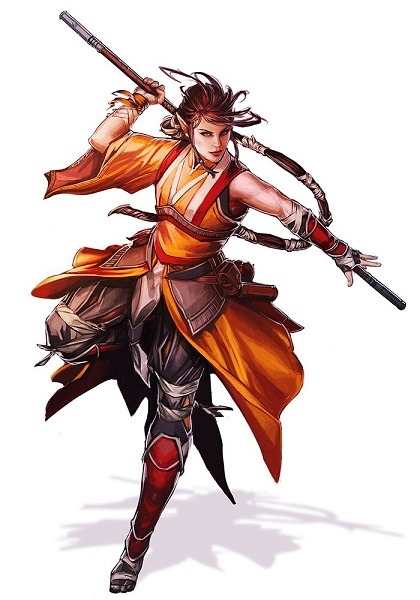
Whatever their discipline, monks are united in their ability to magically harness the energy that flows in their bodies. Whether channelled as a striking display of combat prowess or a subtler focus of defensive ability and speed, this energy infuses all that a monk does.
Monks make careful study of a magical energy that most monastic traditions call ki. This energy is an element of the magic that suffuses the multiverse—specifically, the element that flows through living bodies. Monks harness this power within themselves to create magical effects and exceed their bodies’ physical capabilities, and some of their special attacks can hinder the flow of ki in their opponents. Using this energy, monks channel uncanny speed and strength into their unarmed strikes. As they gain experience, their martial training and their mastery of ki gives them more power over their bodies and the bodies of their foes.
Small walled cloisters dot the landscapes of the worlds of D&D, tiny refuges from the flow of ordinary life, where time seems to stand still. The monks who live there seek personal perfection through contemplation and rigorous training. Many entered the monastery as children, sent to live there when their parents died, when food couldn’t be found to support them, or in return for some kindness that the monks had performed for their families. Some monks live entirely apart from the surrounding population, secluded from anything that might impede their spiritual progress. Others are sworn to isolation, emerging only to serve as spies or assassins at the command of their leader, a noble patron, or some other mortal or divine power. The majority of monks don’t shun their neighbours, making frequent visits to nearby towns or villages and exchanging their service for food and other goods. As versatile warriors, monks often end up protecting their neighbours from monsters or tyrants. For a monk, becoming an adventurer means leaving a structured, communal lifestyle to become a wanderer. This can be a harsh transition, and monks don’t undertake it lightly. Those who leave their cloisters take their work seriously, approaching their adventures as personal tests of their physical and spiritual growth. As a rule, monks care little for material wealth and are driven by a desire to accomplish a greater mission than merely slaying monsters and plundering their treasure.
As you make your monk character, think about your connection to the monastery where you learned your skills and spent your formative years. Were you an orphan or a child left on the monastery’s threshold? Did your parents promise you to the monastery in gratitude for a service performed by the monks? Did you enter this secluded life to hide from a crime you committed? Or did you choose the monastic life for yourself? Consider why you left. Did the head of your monastery choose you for a particularly important mission beyond the cloister? Perhaps you were cast out because of some violation of the community’s rules. Did you dread leaving, or were you happy to go? Is there something you hope to accomplish outside the monastery? Are you eager to return to your home? As a result of the structured life of a monastic community and the discipline required to harness ki, monks are almost always lawful in alignment.
HIT POINTS: 1d8 PER MONK LEVEL
HIT POINTS AT 1st LEVEL: 8 + CON
PROFICIENCIES
ARMOUR: None
WEAPONS: Simple weapons, Shortswords
TOOLS: Choose one artisan’s tools or musical instrument
SAVING THROWS: Strength, Dexterity
SKILLS: Acrobatics, Athletics, History, Insight, Religion, and Stealth (Choose 2)
EQUIPMENT
1. A shortsword OR Any simple weapon
2. A dungeoneer’s pack OR an explorer’s pack
3. 10 darts
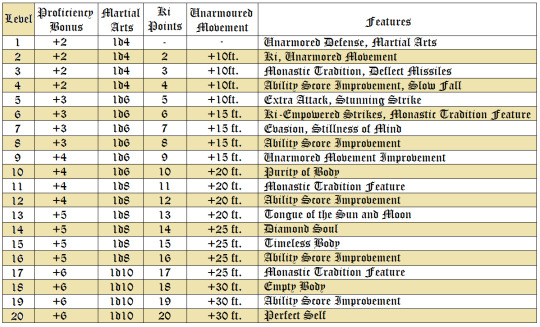
UNARMOURED DEFENCE
Beginning at 1st level, while you are wearing no armour and not wielding a shield, your AC equals 10 + your Dexterity modifier + your Wisdom modifier.
MARTIAL ARTS
At 1st level, your practice of martial arts gives you mastery of combat styles that use unarmed strikes and monk weapons, which are shortswords and any simple melee weapons that don’t have the two-handed or heavy property. You gain the following benefits while you are unarmed or wielding only monk weapons and you aren’t wearing armour or wielding a shield:
You can use Dexterity instead of Strength for the attack and damage rolls of your unarmed strikes and monk weapons.
You can roll a d4 in place of the normal damage of your unarmed strike or monk weapon. This die changes as you gain monk levels, as shown in the Martial Arts column of the Monk table.
When you use the Attack action with an unarmed strike or a monk weapon on your turn, you can make one unarmed strike as a bonus action. For example, if you take the Attack action and attack with a quarterstaff, you can also make an unarmed strike as a bonus action, assuming you haven’t already taken a bonus action this turn.
Certain monasteries use specialized forms of the monk weapons. For example, you might use a club that is two lengths of wood connected by a short chain (called a nunchaku) or a sickle with a shorter, straighter blade (called a kama). Whatever name you use for a monk weapon, you can use the game statistics provided for the weapon in the Weapons section.
Ki
Starting at 2nd level, your training allows you to harness the mystic energy of ki. Your access to this energy is represented by a number of ki points. Your monk level determines the number of points you have, as shown in the Ki Points column of the Monk table. You can spend these points to fuel various ki features. You start knowing three such features: Flurry of Blows, Patient Defence, and Step of the Wind. You learn more ki features as you gain levels in this class. When you spend a ki point, it is unavailable until you finish a short or long rest, at the end of which you draw all of your expended ki back into yourself. You must spend at least 30 minutes of the rest meditating to regain your ki points. Some of your ki features require your target to make a saving throw to resist the feature’s effects. The saving throw DC is calculated as follows:
Ki save DC = 8 + your proficiency bonus + your Wisdom modifier
Flurry of Blows
Immediately after you take the Attack action on your turn, you can spend 1 ki point to make two unarmed strikes as a bonus action.
Patient Defence
You can spend 1 ki point to take the Dodge action as a bonus action on your turn.
Step of the Wind
You can spend 1 ki point to take the Disengage or Dash action as a bonus action on your turn, and your jump distance is doubled for the turn.
UNARMOURED MOVEMENT
Starting at 2nd level, your speed increases by 10 feet while you are not wearing armour or wielding a shield. This bonus increases when you reach certain monk levels, as shown in the Monk table. At 9th level, you gain the ability to move along vertical surfaces and across liquids on your turn without falling during the move.
MONASTIC TRADITION
When you reach 3rd level, you commit yourself to a monastic tradition: the Way of the Open Hand, detailed at the end of the class description or one from another source. Your tradition grants you features at 3rd level and again at 6th, 11th, and 17th level.
DEFLECT MISSILES
Starting at 3rd level, you can use your reaction to deflect or catch the missile when you are hit by a ranged weapon attack. When you do so, the damage you take from the attack is reduced by 1d10 + your Dexterity modifier + your monk level. If you reduce the damage to 0, you can catch the missile if it is small enough for you to hold in one hand and you have at least one hand free. If you catch a missile in this way, you can spend 1 ki point to make a ranged attack with the weapon or piece of ammunition you just caught, as part of the same reaction. You make this attack with proficiency, regardless of your weapon proficiencies, and the missile counts as a monk weapon for the attack, which has a normal range of 20 feet and a long range of 60 feet.
ABILITY SCORE IMPROVEMENT
When you reach 4th level, and again at 8th, 12th, 16th, and 19th level, you can increase one ability score of your choice by 2, or you can increase two ability scores of your choice by 1. As normal, you can’t increase an ability score above 20 using this feature. Using the optional feats rule, you can forgo taking this feature to take a feat of your choice instead.
SLOW FALL
Beginning at 4th level, you can use your reaction when you fall to reduce any falling damage you take by an amount equal to five times your monk level.
EXTRA ATTACK
Beginning at 5th level, you can attack twice, instead of once, whenever you take the Attack action on your turn.
STUNNING STRIKE
Starting at 5th level, you can interfere with the flow of ki in an opponent’s body. When you hit another creature with a melee weapon attack, you can spend 1 ki point to attempt a stunning strike. The target must succeed on a Constitution saving throw or be stunned until the end of your next turn.
KI-EMPOWERED STRIKES
Starting at 6th level, your unarmed strikes count as magical for the purpose of overcoming resistance and immunity to nonmagical attacks and damage.
UNARMOURED MOVEMENT
At 6th level, your Unarmoured Speed speed bonus increases to 15 feet while you are not wearing armour or wielding a shield.
EVASION
At 7th level, your instinctive agility lets you dodge out of the way of certain area effects, such as a blue dragon’s lightning breath or a fireball spell. When you are subjected to an effect that allows you to make a Dexterity saving throw to take only half damage, you instead take no damage if you succeed on the saving throw, and only half damage if you fail.
STILLNESS OF MIND
Starting at 7th level, you can use your action to end one effect on yourself that is causing you to be charmed or frightened.
UNARMOURED MOVEMENT IMPROVEMENT
At 9th level, you gain the ability to move along vertical surfaces and across liquids on your turn without falling during your move.
PURITY OF BODY
At 10th level, your mastery of the ki flowing through you makes you immune to disease and poison.
UNARMOURED MOVEMENT
At 10th level, your Unarmoured Speed speed bonus increases to 20 feet while you are not wearing armour or wielding a shield.
TONGUE OF THE SUN AND MOON
Starting at 13th level, you learn to touch the ki of other minds so that you understand all spoken languages. Moreover, any creature that can understand a language can understand what you say.
DIAMOND SOUL
Beginning at 14th level, your mastery of ki grants you proficiency in all saving throws. Additionally, whenever you make a saving throw and fail, you can spend 1 ki point to reroll it and take the second result.
UNARMOURED MOVEMENT
At 14th level, your Unarmoured Speed speed bonus increases to 25 feet while you are not wearing armour or wielding a shield.
TIMELESS BODY
At 15th level, your ki sustains you so that you suffer none of the frailty of old age, and you can’t be aged magically. You can still die of old age, however. In addition, you no longer need food or water.
EMPTY BODY
Beginning at 18th level, you can use your action to spend 4 ki points to become invisible for 1 minute. During that time, you also have resistance to all damage but force damage. Additionally, you can spend 8 ki points to cast the astral projection spell, without needing material components. When you do so, you can’t take any other creatures with you.
UNARMOURED MOVEMENT
At 18th level, your Unarmoured Speed speed bonus increases to 30 feet while you are not wearing armour or wielding a shield.
PERFECT SELF
At 20th level, when you roll for initiative and have no ki points remaining, you regain 4 ki points.
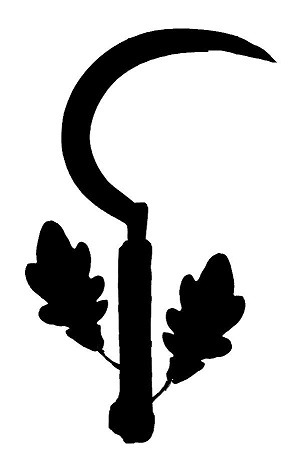
MONASTIC TRADITIONS
Three traditions of monastic pursuit are common in the monasteries scattered across the multiverse. Most monasteries practice one tradition exclusively, but a few honour the three traditions and instruct each monk according to his or her aptitude and interest. All three traditions rely on the same basic techniques, diverging as the student grows more adept. Thus, a monk need choose a tradition only upon reaching 3rd level.
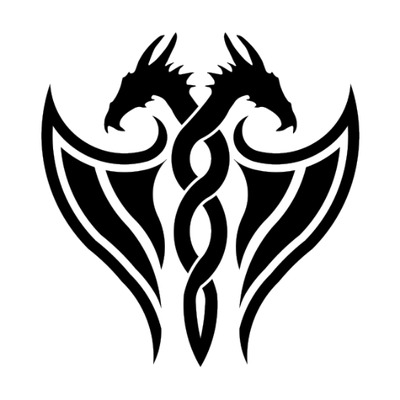
WAY OF MERCY
Monks of the Way of Mercy learn to manipulate the life force of others to bring aid to those in need. They are wandering physicians to the poor and hurt. However, to those beyond their help—whether ailing or evil—they bring a swift end as an act of mercy. Those who follow the Way of Mercy might be humble members of a religious order, administering to those in greatest need, making grim choices rooted in reality rather than idealism. Some might be gentle-voiced healers, beloved by their communities, while others might be masked bringers of macabre mercies. The walkers of this way usually don simple robes with deep cowls, and they often conceal their faces with masks, presenting themselves as the faceless bringers of life and death. If you wear a mask, choose its appearance; for example a raven, a laughing face, a skull etc.
3rd LEVEL – IMPLEMENTS OF MERCY
You gain proficiency in the Insight or Medicine skill (your choice), and you gain proficiency with the herbalism kit and the poisoner’s kit.
3rd LEVEL – HANDS OF HEALING
Your mystical touch can mend wounds. As an action, you can spend 1 ki point to touch a creature and restore a number of hit points equal to a roll of your Martial Arts die + your Wisdom modifier. When you use your Flurry of Blows, you can replace one of the unarmed strikes with a use of this feature without spending its ki cost.
3rd LEVEL – HANDS OF HARM
You use your ki to inflict wounds. When you hit a creature with an unarmed strike, you can spend 1 ki point to deal extra necrotic damage equal to one roll of your Martial Arts die. If the creature is incapacitated or poisoned, the creature takes necrotic damage equal to three rolls of your Martial Arts die instead. You can use this feature only once on each of your turns.
6th LEVEL – NOXIOUS AURA
As a bonus action, you spend 1 ki point to turn your ki into an aura of toxic miasma. The aura extends 5 feet from you in every direction, but not through total cover. It lasts for 1 minute, until you’re incapacitated, or you dismiss it (no action required). While your aura is active, ranged attacks have disadvantage against you. Any other creature that starts its turn in the aura must succeed on a Constitution saving throw or become poisoned until the end of your next turn and take poison damage equal to your Wisdom modifier (minimum of 0 damage).
11th LEVEL – HEALING TECHNIQUE
Your skill in manipulating your ki to heal increases. When you restore hit points to a creature using your Hands of Healing, you can also end one disease or a condition from the following list affecting the target: blinded, deafened, paralysed, or poisoned.
17th LEVEL – HAND OF MERCY
Your mastery of life energy opens the door to the ultimate respite technique. As an action, you can touch a creature, expend 4 ki points, and force the creature to make a Constitution saving throw (a creature can willingly fail this save). Unless the save succeeds, the creature enters a state of suspended animation for a number of days equal to your monk level or until you end the effect early (no action required). During this time, the creature is paralysed, has immunity to all damage, and any curse, disease, or poison affecting it is suspended. The creature appears dead to all outward inspection and to spells used to determine the creature’s status. You can have only one creature under the effect of this feature at a time.

WAY OF THE ASTRAL SELF
Monks of the Way of the Astral Self have an internal struggle with their ki. They see their mystical energy as a representation of their true form, an astral self. This form has the capacity to be a force of good or destruction, with some monasteries training students to either temper their nature or embrace their impulses. The astral self is a translucent embodiment of the monk’s psyche and soul. As a result, the form of an astral self reflects the mind of the monk who manifests it. Your astral self could be a humanoid knight with a helmeted face and large, muscular arms, or it could be a golden metallic form with thin arms like a modron. When choosing this path, consider the quirks that define your monk. Are they obsessed with something? Are you driven by justice or a selfish desire? Any of these motivations could manifest in the form of your astral self.
3rd LEVEL – ARMS OF THE ASTRAL SELF
Your mastery of your ki allows you to summon a portion of your astral self. On your turn, you can spend 2 ki points as a bonus action to summon the arms of your astral self for 10 minutes. These spectral arms hover near your shoulders. You determine the arms’ appearance based on the qualities of your character. While your astral arms are summoned, you gain the following benefits:
You can use your Wisdom modifier in place of your Strength modifier when making Strength checks and Strength saving throws.
The arms are monk weapons and have a reach of 10 feet. The arms deal radiant or necrotic damage (your choice). When you attack with the arms, you can use your Wisdom modifier instead of your Strength or Dexterity modifier for the attack and damage rolls.
Immediately after you use the Attack action with your astral arms on your turn, you can make one extra attack with your astral arms as a bonus action. The number of extra attacks increases when you reach certain levels in this class, increasing to two at 11th level and three at 17th level.
6th LEVEL – VISAGE OF THE ASTRAL SELF
You can summon the visage of your astral self. On your turn, you can spend 1 ki point as a bonus action, or as part of summoning your astral arms, to summon this visage for 10 minutes. The spectral visage covers your face like a helmet or mask. You determine its appearance based on the qualities of your character. While your visage is summoned, you gain the following benefits.
Wisdom of the Spirit. You have advantage on Wisdom (Insight) and Charisma (Intimidation) checks.
Astral Sight. You can see normally in darkness, both magical and nonmagical, to a distance of 120 feet.
11th LEVEL – AWAKENING OF THE ASTRAL SELF
You tap into the greater power of your astral self. While you have both your astral arms and visage summoned, you gain the following benefits.
Deflect Energy. When you take acid, cold, fire, lightning, or force damage, you can use your reaction to deflect it. When you do so, the damage you take is reduced by 1d10 + your Wisdom modifier + your monk level.
Empowered Arms. Once on each of your turns when you hit a target with your astral arms, you can deal extra damage to the target equal to your Martial Arts die.
Word of the Spirit. When you speak through your visage, you can direct your words to a creature of your choice that you can see within 30 feet of you, making it so only that creature can hear you. Alternatively, you can amplify your voice so that all creatures within 600 feet can hear you.
17th LEVEL – COMPLETE ASTRAL SELF
Your connection to your astral self is complete, allowing you summon it entirely. On your turn, you can spend 10 ki points as a bonus action to summon the arms, visage, and body of your astral self for 10 minutes. This spectral body covers your physical form like a suit of armour, connecting with the arms and visage. You determine its appearance based on the qualities of your character. While your astral self is summoned, you gain the following benefits.
Armour of the Spirit. You gain a +2 bonus to AC while you aren’t incapacitated.
Astral Barrage. Whenever you use the Extra Attack feature to attack twice, you can instead attack three times using your astral arms.
Ki Consumption. When a creature within 10 feet of you is reduced to 0 hit points, you can use your reaction to regain ki points equal to your Wisdom modifier (minimum 1).

WAY OF THE OPEN HAND
Monks of the Way of the Open Hand are the ultimate masters of martial arts combat, whether armed or unarmed. They learn techniques to push and trip their opponents, manipulate ki to heal damage to their bodies, and practice advanced meditation that can protect them from harm.
3rd LEVEL – OPEN HAND TECHNIQUE
You can manipulate your enemy’s ki when you harness your own. Whenever you hit a creature with one of the attacks granted by your Flurry of Blows, you can impose one of the following effects on that target:
It must succeed on a Dexterity saving throw or be knocked prone.
It must make a Strength saving throw. If it fails, you can push it up to 15 feet away from you.
It can’t take reactions until the end of your next turn.
6th LEVEL – WHOLENESS OF BODY
You gain the ability to heal yourself. As an action, you can regain hit points equal to three times your monk level. You must finish a long rest before you can use this feature again.
11th LEVEL - TRANQUILITY
You can enter a special meditation that surrounds you with an aura of peace. At the end of a long rest, you gain the effect of a sanctuary spell that lasts until the start of your next long rest (the spell can end early as normal). The saving throw DC for the spell equals 8 + your Wisdom modifier + your proficiency bonus.
17th LEVEL – QUIVERING PALM
You gain the ability to set up lethal vibrations in someone’s body. When you hit a creature with an unarmed strike, you can spend 3 ki points to start these imperceptible vibrations, which last for a number of days equal to your monk level. The vibrations are harmless unless you use your action to end them. To do so, you and the target must be on the same plane of existence. When you use this action, the creature must make a Constitution saving throw. If it fails, it is reduced to 0 hit points. If it succeeds, it takes 10d10 necrotic damage. You can have only one creature under the effect of this feature at a time. You can choose to end the vibrations harmlessly without using an action.
4 notes
·
View notes
Text
Fighter

Fighters learn the basics of all combat styles. Every fighter can swing an axe, fence with a rapier, wield a longsword or a greatsword, use a bow, and even trap foes in a net with some degree of skill. Likewise, a fighter is adept with shields and every form of armour. Beyond that basic degree of familiarity, each fighter specializes in a certain style of combat. Some concentrate on archery, some on fighting with two weapons at once, and some on augmenting their martial skills with magic. This combination of broad general ability and extensive specialization makes fighters superior combatants on battlefields and in dungeons alike.
Not every member of the city watch, the village militia, or the queen’s army is a fighter. Most of these troops are relatively untrained soldiers with only the most basic combat knowledge. Veteran soldiers, military officers, trained bodyguards, dedicated knights, and similar figures are fighters.
Some fighters feel drawn to use their training as adventurers. The dungeon delving, monster slaying, and other dangerous work common among adventurers is second nature for a fighter, not all that different from the life he or she left behind. There are greater risks, perhaps, but also much greater rewards—few fighters in the city watch have the opportunity to discover a magic flame tongue sword, for example.
As you build your fighter, think about two related elements of your character’s background: Where did you get your combat training, and what set you apart from the mundane warriors around you? Were you particularly ruthless? Did you get extra help from a mentor, perhaps because of your exceptional dedication? What drove you to this training in the first place? A threat to your homeland, a thirst for revenge, or a need to prove yourself might all have been factors.
You might have enjoyed formal training in a Noble's army or in a local militia. Perhaps you trained in a war academy, learning strategy, tactics, and military history. Or you might be self-taught—unpolished but well tested. Did you take up the sword as a way to escape the limits of life on a farm, or are you following a proud family tradition? Where did you acquire your weapons and armour.? They might have been military issue or family heirlooms, or perhaps you scrimped and saved for years to buy them. Your armaments are now among your most important possessions—the only things that stand between you and death’s embrace.
HIT POINTS: 1d10 Per Fighter Level
HIT POINTS AT 1st LEVEL: 1d10 + CON
PROFICIENCIES
ARMOUR: All armour, shields.
WEAPONS: Simple weapons, martial weapons.
TOOLS: None.
SAVING THROWS: Strength, Constitution
SKILLS: Acrobatics, Animal Handling, History, Insight, Intimidation, Perception, Survival (Choose 2)
EQUIPMENT
1. Chainmail OR Leather armour, longbow with 20 Arrows
2. A martial weapon and shield OR Two martial weapons
3. A light crossbow with 20 bolts OR Two handaxes
4. A dungeoneer’s pack OR An explorer’s pack
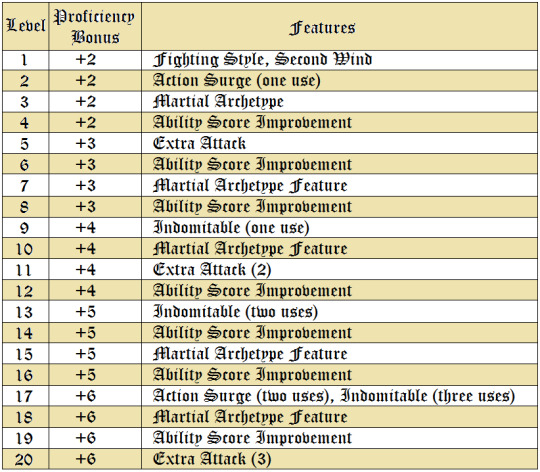
FIGHTING STYLE
You adopt a particular style of fighting as your speciality. Choose one of the following options. You can’t take a Fighting Style option more than once, even if you later get to choose again.
Archery
You gain a +2 bonus to attack rolls you make with ranged weapons.
Defence
While you are wearing armour., you gain a +1 bonus to AC.
Duelling
When you are wielding a melee weapon in one hand and no other weapons, you gain a +2 bonus to damage rolls with that weapon.
Great Weapon Fighting
When you roll a 1 or 2 on a damage die for an attack you make with a melee weapon that you are wielding with two hands, you can reroll the die and must use the new roll, even if the new roll is a 1 or a 2. The weapon must have the two-handed or versatile property for you to gain this benefit.
Protection
When a creature you can see attacks a target other than you that is within 5 feet of you, you can use your reaction to impose disadvantage on the attack roll. You must be wielding a shield.
Two-Weapon Fighting
When you engage in two-weapon fighting, you can add your ability modifier to the damage of the second attack.
SECOND WIND
You have a limited well of stamina that you can draw on to protect yourself from harm. On your turn, you can use a bonus action to regain hit points equal to 1d10 + your fighter level. Once you use this feature, you must finish a short or long rest before you can use it again.
ACTION SURGE
Starting at 2nd level, you can push yourself beyond your normal limits for a moment. On your turn, you can take one additional action. Once you use this feature, you must finish a short or long rest before you can use it again. Starting at 17th level, you can use it twice before a rest, but only once on the same turn.
MARTIAL ARCHETYPE
At 3rd level, you choose an archetype that you strive to emulate in your combat styles and techniques. Choose Champion, Battle Master, or Eldritch Knight, all detailed at the end of the class description. The archetype you choose grants you features at 3rd level and again at 7th, 10th, 15th, and 18th level.
ABILITY SCORE IMPROVEMENT
When you reach 4th level, and again at 6th, 8th, 12th, 14th, 16th, and 19th level, you can increase one ability score of your choice by 2, or you can increase two ability scores of your choice by 1. As normal, you can’t increase an ability score above 20 using this feature. Using the optional feats rule, you can forgo taking this feature to take a feat of your choice instead.
EXTRA ATTACK
Beginning at 5th level, you can attack twice, instead of once, whenever you take the Attack action on your turn. The number of attacks increases to three when you reach 11th level in this class and to four when you reach 20th level in this class.
INDOMITABLE
Beginning at 9th level, you can reroll a saving throw that you fail. If you do so, you must use the new roll, and you can’t use this feature again until you finish a long rest. You can use this feature twice between long rests starting at 13th level and three times between long rests starting at 17th level.

MARTIAL ARCHETYPES
Different fighters choose different approaches to perfecting their fighting prowess. The martial archetype you choose to emulate reflects your approach.

CHAMPION
The archetypal Champion focuses on the development of raw physical power honed to deadly perfection. Those who model themselves on this archetype combine rigorous training with physical excellence to deal devastating blows.
3rd LEVEL – IMPROVED CRITICAL
Beginning when you choose this archetype at 3rd level, your weapon attacks score a critical hit on a roll of 19 or 20.
7th LEVEL – REMARKABLE ATHLETE
Starting at 7th level, you can add half your proficiency bonus (round up) to any Strength, Dexterity, or Constitution check you make that doesn’t already use your proficiency bonus. In addition, when you make a running long jump, the distance you can cover increases by a number of feet equal to your Strength modifier.
10th LEVEL -ADDITIONAL FIGHTING STYLE
You can choose a second option from the Fighting Style class feature.

PSYCHIC WARRIOR
Awakening to the psionic power within themselves, a Psychic Warrior is a fighter who augments their physical might with psychically infused weapon strikes, telekinetic lashes, and barriers of mental force. As a Psychic Warrior, you might have honed your psionic abilities through your own disciplined practice, unlocked it under the tutelage of a master, or developed it at an academy dedicated to wielding the mind’s power as both weapon and shield.
3rd LEVEL – PSYCHIC ARMAMENT
You can channel your psychic power to magically augment your prowess. When you finish a long rest, choose whether to augment your defences or your strikes. The chosen benefit lasts until you finish a long rest.
Augmented Defences
When you or a creature you can see within 30 feet of you takes damage, you can use your reaction to roll a d10 and reduce the amount of damage taken by the number rolled. When you reach 10th level in this class, the die changes to a d12.
Augmented Strikes
Once during each of your turns when you hit a creature with a weapon attack, you can also deal 1d4 psychic damage to that target. When you reach 10th level in this class, the psychic damage increases to 1d6.
3rd LEVEL – TELEKINETIC HAND
You learn the mage hand cantrip. You can cast it without components, and you can make the spectral hand invisible. Intelligence is your spellcasting ability for this spell.
7th LEVEL – STRENGTH OF MIND
As a bonus action, you can telekinetically lash out at a creature you can see within 20 feet of you. The target must make a Strength saving throw against a DC equal to 8 + your proficiency bonus + your Intelligence modifier. On a failed save, the target takes force damage equal to 2d6 plus your Intelligence modifier and is telekinetically moved 15 feet directly toward or away from you (your choice). On a successful save, it takes half as much damage and isn’t moved. You can use this feature a number of times equal to your Intelligence modifier (minimum of once), and you regain all expended uses when you finish a long rest.
10th LEVEL – TELEKINETIC BULWARK
When you take the Attack action, you can forgo one of your attacks to project a bastion of psionic power in a 10-foot radius around yourself. It lasts for 1 minute or until you’re incapacitated. For the duration, you and your allies in that area gain the benefits of half cover and have advantage on Strength saving throws. Once you use this feature, you can’t do so again until you finish a long rest or until after you use your Second Wind feature.
15th LEVEL – AGONIZING STRIKE
Your attacks can channel psychic agony. When you hit a creature with a weapon attack, you can also deal 2d10 psychic damage to that target and force it to make a Constitution saving throw against a DC equal to 8 + your proficiency bonus + your Intelligence modifier. Unless the save succeeds, the target falls prone, and it suffers disadvantage on ability checks until the end of your next turn. You can use this feature a number of times equal to your Intelligence modifier (minimum of once), and you regain all expended uses when you finish a long rest.
18th LEVEL – PSYCHIC DREADNOUGHT
The power of your mind suffuses your entire being, making you a nigh-unstoppable force on the battlefield. Using your reaction when you take damage, you can give yourself the following benefits for 1 minute or until you’re incapacitated:
At the start of each of your turns, you regain 10 hit points.
Your walking speed increases by 10 feet.
If you’re prone, you can stand up by spending 5 feet of movement.
Once you activate this feature, you can’t use it again until you finish a long rest.

RUNE KNIGHT
You discovered how to enhance your martial prowess using the supernatural power of runes. The ancient practice of rune magic originated with giants. Skiltgravr (“rune cutters”) can be found among any type of giants, and you likely learned your methods first or second hand from such a mystical artisan. Whether you found the giant’s work carved into a hill or cave, learned of the runes from a travelling sage, or met the giant in person, you studied the giant’s craft. In time, you learned how to carve and apply runes to your equipment and how to invoke their magic, ultimately becoming a Rune Knight.
3rd LEVEL – BONUS PROFICIENCIES
You gain proficiency with smith’s tools, and you learn to speak, read, and write Giant.
3rd LEVEL – RUNE MAGIC
You learn how to use runes to enhance your gear. When you gain this feature, you learn how to inscribe two runes of your choice on weapons, armour., or shields. Whenever you finish a long rest, you can touch a number of objects equal to the number of runes you know, and you inscribe a different rune onto each of the objects. To be eligible, an object must be a weapon, a suit of armour., or a shield. Your rune remains on an object until you finish a long rest, and an object can bear only one of your runes. Each time you gain a level in this class, you can replace one rune you know with a different one.
RUNE OPTIONS
Here are rune options for the Rune Magic feature. They are all magical effects. If a rune requires a saving throw, your Rune Magic save DC equals 8 + your proficiency bonus + your Intelligence modifier.
Haug (Hill Rune)
This rune’s magic bestows a resilience reminiscent of a hill giant. While wearing or carrying an object inscribed with this rune, you have advantage on saving throws against being poisoned, and you have resistance against poison damage. In addition, you can invoke the rune as a bonus action, gaining resistance to bludgeoning, piercing, and slashing damage for 1 minute. Once you invoke the rune, you can’t do so again until you finish a short or long rest.
Ild (Fire Rune)
This rune’s magic channels the masterful craftsmanship of fire giant smiths. While wearing or carrying an object inscribed with this rune, your proficiency bonus is doubled for any ability check you make that uses your proficiency with a tool. In addition, when you hit a creature with a weapon attack, you can invoke the rune to summon fiery shackles: the target must succeed on a Strength saving throw or be restrained for 1 minute. While restrained by the shackles, the target takes 2d6 fire damage at the start of each of its turns. The target can repeat the saving throw at the end of each of its turns, banishing the shackles on a success. Once you invoke the rune, you can’t do so again until you finish a short or long rest.
Ise (Frost Rune)
This rune’s magic evokes a frost giant’s stoic calm. While wearing or carrying an object inscribed with this rune, you have advantage on Wisdom (Animal Handling) checks and Charisma (Intimidation) checks. In addition, you can invoke the rune as a bonus action to increase your Strength score by 2 for 10 minutes. This increase can cause your score to exceed 20, but not 30. Once you invoke the rune, you can’t do so again until you finish a short or long rest.
Skye (Cloud Rune)
This rune’s magic emulates the deceptiveness of a cloud giant. While wearing or carrying an object inscribed with this rune, you have advantage on Dexterity (Sleight of Hand) checks and Charisma (Deception) checks. In addition, when you or a creature you can see within 30 feet of you is hit by an attack roll, you can use your reaction to invoke the rune and cause that attack to target a different creature within 30 feet of you (other than the attacker), using the same roll. This magic can transfer the attack regardless of the attack’s range. Once you invoke the rune, you can’t do so again until you finish a short or long rest.
Stein (Stone Rune)
This rune’s magic channels the insightfulness of a stone giant. While wearing or carrying an object inscribed with this rune, you have advantage on Wisdom (Insight) checks, and you have darkvision out to a range of 60 feet. If you already have darkvision, its range increases by 30 feet. In addition, when a creature you can see ends its turn within 30 feet of you, you can use your reaction to invoke the rune and force the creature to make a Wisdom saving throw. Unless the save succeeds, the creature is charmed by you for 1 minute. While charmed in this way, the creature has a speed of 0 and is incapacitated, descending into a dreamy stupor. The effect ends if the charmed creature takes any damage or if someone else uses an action to shake the creature out of its haze. Once you invoke the rune, you can’t do so again until you finish a short or long rest.
Uvar (Storm Rune)
Using this rune, you can glimpse the future like a storm giant. While wearing or carrying an object inscribed with this rune, you have advantage on Intelligence (Arcana) checks, and you can’t be surprised as long as you are not incapacitated. In addition, you can invoke the rune as a bonus action to enter a prophetic state for 1 minute or until you’re incapacitated. Until the state ends, when you or another creature you can see within 60 feet of you makes an attack roll, a saving throw, or an ability check, you can use your reaction to cause the roll to have advantage or disadvantage. Once you invoke the rune, you can’t do so again until you finish a short or long rest.
3rd LEVEL – GIANT MIGHT
You can imbue yourself with the might of giants. As a bonus action, you magically gain the following benefits, which last for 1 minute:
If you are smaller than Large, you become Large, along with anything you are wearing. If you lack the room to become Large, your size doesn’t change.
You have advantage on Strength checks and Strength saving throws.
Your weapon attacks deal an extra 1d6 damage.
You can use this feature twice, and you regain all expended uses of it when you finish a long rest.
7th LEVEL – DEFENSIVE RUNES
You learn to invoke your rune magic to protect your allies. When another creature you can see within 60 feet of you is hit by an attack roll, you can use your reaction to grant a bonus to the creature’s AC against that attack. The bonus equals 1 + your Intelligence modifier (minimum of +2). In addition, you learn one new rune of your choice from the Rune Magic feature (for a total of three).
10th LEVEL – GREAT STATURE
The magic of your runes permanently alters you. When you gain this feature, roll 3d4. You grow a number of inches in height equal to the roll. Moreover, the extra damage you deal with your Giant Might feature increases to 1d8. In addition, you learn one new rune of your choice from your Rune Magic feature (for a total of four).
15th LEVEL – RUNE MAGIC MASTERY
You can invoke each rune you know from your Rune Magic feature twice, rather than once, and you regain all expended uses when you finish a short or long rest. In addition, you learn one new rune of your choice from the Rune Magic feature (for a total of five).
18th LEVEL – BLESSING OF THE ALL FATHER
You learn how to share your rune magic with your allies. When you use your Giant Might feature, you can choose one willing creature you can see within 60 feet of you. The chosen creature also gains the benefits of your Giant Might feature.
4 notes
·
View notes
Text
Bard Spell List
Cantrips
Dancing Lights
Light
Mage Hand
Mending
Message
Minor Illusion
Prestidigitation
True Strike
Vicious Mockery
1st Level
Animal Friendship
Bane
Charm Person
Comprehend Languages
Cure Wounds
Detect Magic
Disguise Self
Faerie Fire
Feather Fall
Healing Word
Heroism
Hideous Laughter
Identify
Illusory Script
Longstrider
Silent Image
Sleep
Speak with Animals
Thunderwave
Unseen Servant
2nd level
Animal Messenger
Blindness/Deafness
Calm Emotions
Detect Thoughts
Enhance Ability
Enthrall
Heat Metal
Hold Person
Invisibility
Knock
Lesser Restoration
Locate Animals or Plants
Locate Object
Magic Mouth
See Invisibility
Shatter
Silence
Suggestion
Zone of Truth
3rd level
Bestow Curse
Clairvoyance
Dispel Magic
Fear
Glyph of Warding
Hypnotic Pattern
Major Image
Nondetection
Plant Growth
Sending
Speak with Dead
Speak with Plants
Stinking Cloud
Tiny Hut
Tongues
4th level
Compulsion
Confusion
Dimension Door
Freedom of Movement
Greater Invisibility
Hallucinatory Terrain
Locate Creature
Polymorph
5th level
Animate Objects
Awaken
Dominate Person
Dream
Geas
Greater Restoration
Hold Monster
Legend Lore
Mass Cure Wounds
Mislead
Modify Memory
Planar Binding
Raise Dead
Scrying
Seeming
Teleportation Circle
6th level
Eyebite
Find the Path
Guards and Wards
Irresistible Dance
Mass Suggestion
Programmed Illusion
True Seeing
7th level
Arcane Sword
Etherealness
Forcecage
Magnificent Mansion
Mirage Arcane
Project Image
Regenerate
Resurrection
Symbol
Teleport
8th level
Dominate Monster
Feeblemind
Glibness
Mind Blank
Power Word Stun
9th level
Foresight
Power Word Kill
True Polymorph
1 note
·
View note
Text
Cleric Spell List
Cantrips
Guidance
Light
Mending
Resistance
Sacred Flame
Spare the Dying
Thaumaturgy
1st Level
Bane
Bless*
Command
Create or Destroy Water
Cure Wounds*
Detect Evil and Good
Detect Magic
Detect Poison and Disease
Guiding Bolt
Healing Word
Inflict Wounds
Protection from Evil and Good
Purify Food and Drink
Sanctuary
Shield of Faith
Twilight Domain 1st Level: Faerie Fire
Sleep
Unity Domain 1st Level: Heroism
Shield of Faith
2nd Level
Aid
Augury
Blindness/Deafness
Calm Emotions
Continual Flame
Enhance Ability
Find Traps
Gentle Repose
Hold Person
Lesser Restoration**
Locate Object
Prayer of Healing
Protection from Poison
Silence
Spiritual Weapon**
Warding Bond
Zone of Truth
3rd Level
Animate Dead
Beacon of Hope***
Bestow Curse
Clairvoyance
Create Food and Water
Daylight
Dispel Magic
Glyph of Warding
Magic Circle
Mass Healing Word
Meld into Stone
Protection from Energy
Remove Curse
Revivify***
Sending
Speak with Dead
Spirit Guardians
Tongues
Water Walk
Twilight Domain 3rd Level: Darkness
Invisibility
Unity Domain 3rd Level: Aid
Warding Bond
4th-level
Banishment
Control Water
Death Ward****
Divination
Freedom of Movement
Guardian of Faith****
Locate Creature
Stone Shape
5th-level
Commune
Contagion
Dispel Evil and Good
Flame Strike
Geas
Greater Restoration
Hallow
Insect Plague
Legend Lore
Mass Cure Wounds*****
Planar Binding
Raise Dead*****
Scrying
Twilight Domain 5th Level: Aura of Vitality
Leomund’s Tiny Hut
Unity Domain 5th Level: Beacon of Hope
Sending
6th-level
Blade Barrier
Create Undead
Find the Path
Forbiddance
Harm
Heal
Heroes’ Feast
Planar Ally
True Seeing
Word of Recall
7th-level
Conjure Celestial
Divine Word
Etherealness
Fire Storm
Plane Shift
Regenerate
Resurrection
Symbol
Twilight Domain 7th Level: Aura of Life
Greater Invisibility
Unity Domain 7th Level: Aura of Purity
Guardian of Faith
8th-level
Anti-magic Field
Control Weather
Earthquake
Holy Aura
9th-level
Astral Projection
Gate
Mass Heal
True Resurrection
Twilight Domain 9th Level: Circle of Power
Dream
Unity Domain 9th Level: Greater Restoration
Rary’s Telepathic Bond
* Life Domain 1st Level
** Life Domain 3rd Level
*** Life Domain 5th Level
**** Life Domain 7th Level
***** Life Domain 9th Level
4 notes
·
View notes
Text
Classes
Barbarian
https://burkesguidetodnd.tumblr.com/post/611519854950891520/barbarian
Bard
https://burkesguidetodnd.tumblr.com/post/611519867805401088/bard
Cleric
https://burkesguidetodnd.tumblr.com/post/611519872533397504/cleric
Druid
https://burkesguidetodnd.tumblr.com/post/612068013457489920/druid
Fighter
https://burkesguidetodnd.tumblr.com/post/612057256083800064/fighter
Monk
https://burkesguidetodnd.tumblr.com/post/612066775633461248/monk
5 notes
·
View notes
Text
Races
Dragonborn
https://burkesguidetodnd.tumblr.com/post/190789371206/dragonborn
Dwarf
https://burkesguidetodnd.tumblr.com/post/190874211531/dwarf
Elf
https://burkesguidetodnd.tumblr.com/post/190981089196/elf
Gnome
https://burkesguidetodnd.tumblr.com/post/190981222816/gnome
Half Elf
https://burkesguidetodnd.tumblr.com/post/190981312366/half-elf
Halfling
https://burkesguidetodnd.tumblr.com/post/190981411466/halfling
Half Orc
https://burkesguidetodnd.tumblr.com/post/190981493591/half-orc
Human
https://burkesguidetodnd.tumblr.com/post/190981548831/human
Tiefling
https://burkesguidetodnd.tumblr.com/post/190981616416/tiefling
3 notes
·
View notes
Text
Cleric
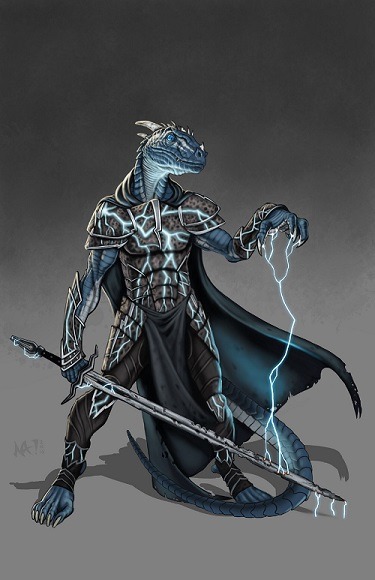
Clerics are intermediaries between the mortal world and the distant planes of the gods. As varied as the gods they serve, clerics strive to embody the handiwork of their deities. No ordinary priest, a cleric is imbued with divine magic.
Divine magic, as the name suggests, is the power of the gods, flowing from them into the world. Clerics are conduits for that power, manifesting it as miraculous effects. The gods don’t grant this power to everyone who seeks it, but only to those chosen to fulfil a high calling. Harnessing divine magic doesn’t rely on study or training. A cleric might learn formulaic prayers and ancient rites, but the ability to cast cleric spells relies on devotion and an intuitive sense of a deity’s wishes. Clerics combine the helpful magic of healing and inspiring their allies with spells that harm and hinder foes. They can provoke awe and dread, lay curses of plague or poison, and even call down flames from heaven to consume their enemies. For those evildoers who will benefit most from a mace to the head, clerics depend on their combat training to let them wade into melee with the power of the gods on their side.
As you create a cleric, the most important question to consider is which deity to serve and what principles you want your character to embody. The Gods of the Multiverse section includes lists of many of the gods of the multiverse. Check with your DM to learn which deities are in your campaign. Once you’ve chosen a deity, consider your cleric’s relationship to that god. Did you enter this service willingly? Or did the god choose you, impelling you into service with no regard for your wishes? How do the temple priests of your faith regard you: as a champion or a troublemaker? What are your ultimate goals? Does your deity have a special task in mind for you? Or are you striving to prove yourself worthy of a great quest?
HIT POINTS: 1d8 Per Cleric Level
HIT POINTS AT 1st LEVEL: 1d8 + CON
PROFICIENCIES
ARMOUR: Light, Medium, Shields
WEAPONS: Simple
TOOLS: None
SAVING THROWS: Wisdom, Charisma
SKILLS: History, Insight, Medicine, Persuasion, and Religion (Choose 2)
STARING EQUIPMENT
1. Mace OR Warhammer (if proficient)
2. Scale mail OR Leather armour OR Chain mail (if proficient)
3. Light crossbow (20 bolts) OR Any simple weapon
4. A priest’s pack OR An explorer’s pack
5. A shield AND a holy symbol
FEATURES

SPELLCASTING
As a conduit for divine power, you can cast cleric spells. See Spells Rules for the general rules of spellcasting and the Spells Listing for the cleric spell list.
Cantrips
At 1st level, you know three cantrips of your choice from the cleric spell list. You learn additional cleric cantrips of your choice at higher levels, as shown in the Cantrips Known column of the Cleric table.
Preparing and Casting Spells
The Cleric table shows how many spell slots you have to cast your cleric spells of 1st level and higher. To cast one of these spells, you must expend a slot of the spell’s level or higher. You regain all expended spell slots when you finish a long rest. You prepare the list of cleric spells that are available for you to cast, choosing from the cleric spell list. When you do so, choose a number of cleric spells equal to your Wisdom modifier + your cleric level (minimum of one spell). The spells must be of a level for which you have spell slots. For example, if you are a 3rd-level cleric, you have four 1st-level and two 2nd-level spell slots. With a Wisdom of 16, your list of prepared spells can include six spells of 1st or 2nd level, in any combination. If you prepare the 1st-level spell cure wounds, you can cast it using a 1st-level or 2nd-level slot. Casting the spell doesn’t remove it from your list of prepared spells. You can change your list of prepared spells when you finish a long rest. Preparing a new list of cleric spells requires time spent in prayer and meditation: at least 1 minute per spell level for each spell on your list.
Spellcasting Ability
Wisdom is your spellcasting ability for your cleric spells. The power of your spells comes from your devotion to your deity. You use your Wisdom whenever a cleric spell refers to your spellcasting ability. In addition, you use your Wisdom modifier when setting the saving throw DC for a cleric spell you cast and when making an attack roll with one.
Spell save DC = 8 + your proficiency bonus + your Wisdom modifier
Spell attack modifier = your proficiency bonus + your Wisdom modifier
Ritual Casting
You can cast a cleric spell as a ritual if that spell has the ritual tag and you have the spell prepared.
Spellcasting Focus
You can use a holy symbol (see the Adventuring Gear section) as a spellcasting focus for your cleric spells.
DIVINE DOMAIN
Choose one domain related to your deity: Knowledge, Life, Light, Nature, Tempest, Trickery, or War. The Life domain is detailed at the end of the class description and provides examples of gods associated with it. Your choice grants you domain spells and other features when you choose it at 1st level. It also grants you additional ways to use Channel Divinity when you gain that feature at 2nd level, and additional benefits at 6th, 8th, and 17th levels.
Domain Spells
Each domain has a list of spells — its domain spells — that you gain at the cleric levels noted in the domain description. Once you gain a domain spell, you always have it prepared, and it doesn’t count against the number of spells you can prepare each day. If you have a domain spell that doesn’t appear on the cleric spell list, the spell is nonetheless a cleric spell for you.
CHANNEL DIVINITY
At 2nd level, you gain the ability to channel divine energy directly from your deity, using that energy to fuel magical effects. You start with two such effects: Turn Undead and an effect determined by your domain. Some domains grant you additional effects as you advance in levels, as noted in the domain description. When you use your Channel Divinity, you choose which effect to create. You must then finish a short or long rest to use your Channel Divinity again. Some Channel Divinity effects require saving throws. When you use such an effect from this class, the DC equals your cleric spell save DC. Beginning at 6th level, you can use your Channel Divinity twice between rests, and beginning at 18th level, you can use it three times between rests. When you finish a short or long rest, you regain your expended uses.
Channel Divinity: Turn Undead
As an action, you present your holy symbol and speak a prayer censuring the undead. Each undead that can see or hear you within 30 feet of you must make a Wisdom saving throw. If the creature fails its saving throw, it is turned for 1 minute or until it takes any damage. A turned creature must spend its turns trying to move as far away from you as it can, and it can’t willingly move to a space within 30 feet of you. It also can’t take reactions. For its action, it can use only the Dash action or try to escape from an effect that prevents it from moving. If there’s nowhere to move, the creature can use the Dodge action.
ABILITY SCORE IMPROVEMENT
When you reach 4th level, and again at 8th, 12th, 16th, and 19th level, you can increase one ability score of your choice by 2, or you can increase two ability scores of your choice by 1. As normal, you can’t increase an ability score above 20 using this feature.
DESTROY UNDEAD
Starting at 5th level, when an undead fails its saving throw against your Turn Undead feature, the creature is instantly destroyed if its challenge rating is at or below a certain threshold, as shown in the Destroy Undead table.
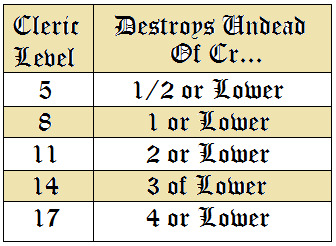
DIVINE INTERVENTION
Beginning at 10th level, you can call on your deity to intervene on your behalf when your need is great. Imploring your deity’s aid requires you to use your action. Describe the assistance you seek, and roll percentile dice. If you roll a number equal to or lower than your cleric level, your deity intervenes. The DM chooses the nature of the intervention; the effect of any cleric spell or cleric domain spell would be appropriate. If your deity intervenes, you can’t use this feature again for 7 days. Otherwise, you can use it again after you finish a long rest. At 20th level, your call for intervention succeeds automatically, no roll required.
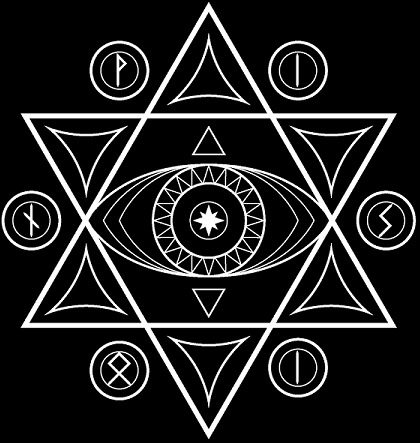
DIVINE DOMAINS
In a pantheon, every deity has influence over different aspects of mortal life and civilization, called a deity’s domain. All the domains over which a deity has influence are called the deity’s portfolio. For example, the portfolio of the Greek god Apollo includes the domains of Knowledge, Life, and Light. As a cleric, you choose one aspect of your deity’s portfolio to emphasize, and you are granted powers related to that domain. Your choice might correspond to a particular sect dedicated to your deity. Apollo, for example, could be worshipped in one region as Phoebus (“radiant”) Apollo, emphasizing his influence over the Light domain, and in a different place as Apollo Acesius (“healing”), emphasizing his association with the Life domain. Alternatively, your choice of domain could simply be a matter of personal preference, the aspect of the deity that appeals to you most. Each domain’s description gives examples of deities who have influence over that domain. Gods are included from the worlds of the Forgotten Realms, Greyhawk, Dragonlance, and Eberron campaign settings, as well as from the Celtic, Greek, Norse, and Egyptian pantheons of antiquity.

LIFE DOMAIN
The Life domain focuses on the vibrant positive energy — one of the fundamental forces of the universe — that sustains all life. The gods of life promote vitality and health through healing the sick and wounded, caring for those in need, and driving away the forces of death and undeath. Almost any non-evil deity can claim influence over this domain, particularly agricultural deities (such as Chauntea, Arawai, and Demeter), sun gods (such as Lathander, Pelor, and Re-Horakhty), gods of healing or endurance (such as Ilmater, Mishakal, Apollo, and Diancecht), and gods of home and community (such as Hestia, Hathor, and Boldrei).
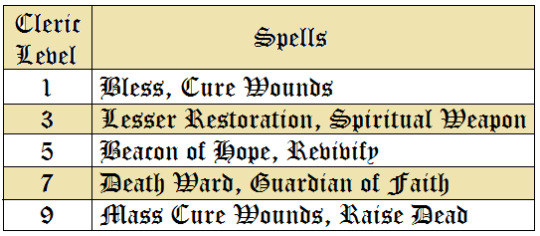
1st LEVEL – BONUS PROFICIENCY
When you choose this domain at 1st level, you gain proficiency with heavy armour.
1st LEVEL – DISCIPLE OF LIFE
Also starting at 1st level, your healing spells are more effective. Whenever you use a spell of 1st level or higher to restore hit points to a creature, the creature regains additional hit points equal to 2 + the spell’s level.
2nd LEVEL – CHANNEL DIVINITY: PRESERVE LIFE
Starting at 2nd level, you can use your Channel Divinity to heal the badly injured. As an action, you present your holy symbol and evoke healing energy that can restore a number of hit points equal to five times your cleric level. Choose any creatures within 30 feet of you, and divide those hit points among them. This feature can restore a creature to no more than half of its hit point maximum. You can’t use this feature on an undead or a construct.
6th LEVEL – BLESSED HEALER
Beginning at 6th level, the healing spells you cast on others heal you as well. When you cast a spell of 1st level or higher that restores hit points to a creature other than you, you regain hit points equal to 2 + the spell’s level.
8th LEVEL – DIVINE STRIKE
At 8th level, you gain the ability to infuse your weapon strikes with divine energy. Once on each of your turns when you hit a creature with a weapon attack, you can cause the attack to deal an extra 1d8 radiant damage to the target. When you reach 14th level, the extra damage increases to 2d8.
17th LEVEL – SUPREME HEALING
Starting at 17th level, when you would normally roll one or more dice to restore hit points with a spell, you instead use the highest number possible for each die. For example, instead of restoring 2d6 hit points to a creature, you restore 12.
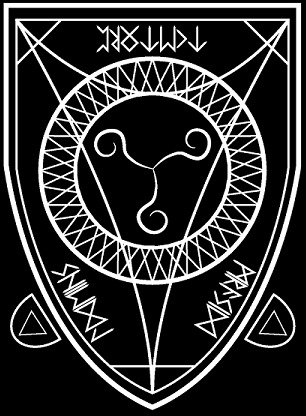
TWILIGHT DOMAIN
The Twilight Domain governs the transition and blending of light into darkness. It is a time of rest and comfort, but also the threshold between safety and the unknown. Deities of healing or respite (such as Boldre, Hestia, Mishakal, or Pelor), bravery or protection (such as Dol Arrah, Hajama, Helm, or Ilmater), travel or transition (such as Fharlanghn, Hermes, the Raven Queen, or the Traveller), or the night and dreams (such as Celestian, Morpheus, Nut, or Selûne) might grant their clerics the Twilight Domain. Clerics who serve these deities tend to be brave, delving into the dark to hold its dangers at bay and to bring comfort to those lost far from the light.
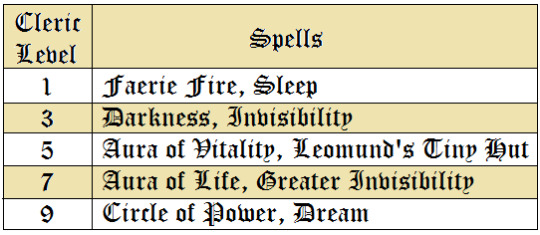
1st LEVEL – BONUS PROFICIENCIES
You gain proficiency with martial weapons and heavy armour.
1st LEVEL – EYES OF NIGHT
Your eyes are blessed, allowing you to see through the deepest gloom. You have darkvision with no maximum range; you can see in dim light as if it were bright light and in darkness as if it were dim light. As an action, you can magically give the benefit of this feature to any number of creatures you can see within 10 feet of you. The shared benefit lasts for 10 minutes. You can extend this benefit a number of times equal to your Wisdom modifier (a minimum of once), and you regain all expended uses when you finish a long rest.
1st LEVEL – VIGILANT BLESSING
The night has taught you to be vigilant. As an action, you give one creature you touch (including possibly yourself) advantage on the next initiative roll the creature makes. This benefit ends immediately after the roll or if you use this feature again.
2nd LEVEL – CHANNEL DIVINITY: TWILIGHT SANCTUARY
You can use your Channel Divinity to refresh your allies with soothing twilight. As an action, you present your holy symbol, and a sphere of twilight emanates from you. The sphere is centred on you, has a 30-foot radius, and is filled with dim light. The sphere moves with you, and it lasts for 1 minute or until you are incapacitated or die. Whenever a creature (including you) ends its turn in the sphere, you can grant that creature one of these benefits:
Give it 1d8 temporary hit points.
End one effect causing it to be charmed or frightened.
6th LEVEL – STEPS OF THE BRAVE
You draw strength from your connection to twilight and find yourself at home within its dark embrace, gaining two benefits:
You have advantage on saving throws against being frightened.
If you are in dim light or darkness, you can use a bonus action to magically give yourself a flying speed equal to your walking speed until the end of your next turn.
8th LEVEL – DIVINE STRIKE
You gain the ability to infuse your weapon strikes with divine energy. Once on each of your turns when you hit a creature with a weapon attack, you can cause the attack to deal an extra 1d8 psychic damage. When you reach 14th level, the extra damage increases to 2d8.
17th LEVEL – MIDNIGHT SHROUD
You can harness the shrouding power of night to protect your allies and stymie your foes. Whenever you cast the darkness spell using a spell slot, you can choose a number of creatures that you can see (including yourself) equal to your Wisdom modifier (minimum of one). The chosen creatures can see through the darkness.

UNITY DOMAIN
A sense of oneness shines at the heart of healthy communities, whether bound together by friendship, blood, faith, or some other uniting force. The gods of unity deepen such bonds and delight in their strength. Clerics of these gods preside over marriages and other familial bonding customs, but they also nurture the emotional bonds of friendship and camaraderie. Their divine blessings bolster and protect allies in battle through these deep bonds and turn aside malign influences.
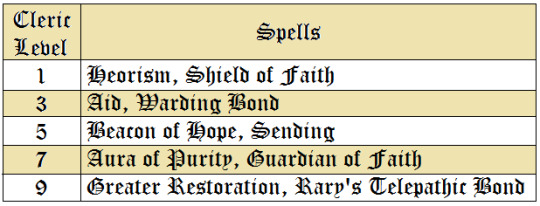
1st LEVEL – EMBOLDENING BOND
You can forge an empowering bond between allies. As an action, you can choose two willing creatures you can see within 30 feet of you (this can include yourself) and create a magical bond between them. While either bonded creature is within 30 feet of the other, the creature can roll a d4 and add the number rolled to an attack roll, an ability check, or a saving throw it makes. Each creature can add the d4 no more than once per turn. The bond lasts for 1 hour or until you use this feature again. You can use this feature once, and you regain the ability to do so when you finish a long rest. You can also expend a spell slot to use the feature again.
2nd LEVEL – CHANNEL DIVINITY: SHARED BURDEN
When a creature you can see within 30 feet of you takes damage, you can use your reaction to choose a number of other willing creatures you can see, up to a number of creatures equal to your Wisdom modifier (minimum of one creature). Distribute the damage taken between the original target and the chosen creatures. Each creature must take at least 1 damage. Apply any damage resistance or vulnerability of the creatures involved after you distribute the damage.
6th LEVEL – PROTECTIVE BOND
The bond you forge between people shields them from harm. While either creature chosen for your Emboldening Bond feature is within 30 feet of the other, the creature can use its reaction to grant resistance to all damage to the other creature when that other creature takes damage. This resistance lasts until the end of the current turn.
8th LEVEL – POTENT SPELLCASTING
You add your Wisdom modifier to the damage you deal with any cleric cantrip.
17th LEVEL – ENDURING UNITY
The bonds you create endure across vast distances. Creatures affected by your Emboldening Bond feature gain its benefits, as well as those of your Protective Bond feature, while they are on the same plane of existence as each other. Additionally, when a creature chosen for your Emboldening Bond is reduced to 0 hit points, their bonded partner gains the following benefits for 1 minute, or until the creature regains at least 1 hit point:
The creature has advantage on attack rolls, ability checks, and saving throws
The creature gains resistance to all damage
As an action, the creature can touch their bonded partner to expend and roll any number of Hit Dice. Their bonded partner regains a number of hit points equal to the total rolled.
Cleric Spell List
https://burkesguidetodnd.tumblr.com/post/611582281206906880/cleric-spell-list
6 notes
·
View notes
Text
Bard
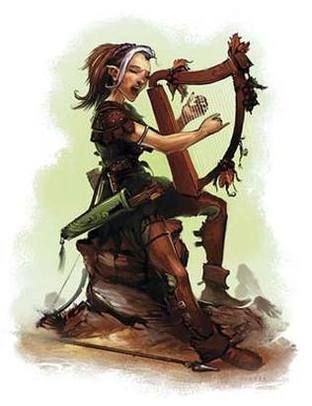
In the worlds of D&D, words and music are not just vibrations of air, but vocalizations with power all their own. The bard is a master of song, speech, and the magic they contain. Bards say that the multiverse was spoken into existence, that the words of the gods gave it shape, and that echoes of these primordial Words of Creation still resound throughout the cosmos. The music of bards is an attempt to snatch and harness those echoes, subtly woven into their spells and powers. The greatest strength of bards is their sheer versatility. Many bards prefer to stick to the sidelines in combat, using their magic to inspire their allies and hinder their foes from a distance. But bards are capable of defending themselves in melee if necessary, using their magic to bolster their swords and armour. Their spells lean toward charms and illusions rather than blatantly destructive spells. They have a wide-ranging knowledge of many subjects and a natural aptitude that lets them do almost anything well. Bards become masters of the talents they set their minds to perfecting, from musical performance to esoteric knowledge.
True bards are not common in the world. Not every minstrel singing in a tavern or jester cavorting in a royal court is a bard. Discovering the magic hidden in music requires hard study and some measure of natural talent that most troubadours and jongleurs lack. It can be hard to spot the difference between these performers and true bards, though. A bard’s life is spent wandering across the land gathering lore, telling stories, and living on the gratitude of audiences, much like any other entertainer. But a depth of knowledge, a level of musical skill, and a touch of magic set bards apart from their fellows. Only rarely do bards settle in one place for long, and their natural desire to travel—to find new tales to tell, new skills to learn, and new discoveries beyond the horizon—makes an adventuring career a natural calling. Every adventure is an opportunity to learn, practice a variety of skills, enter long-forgotten tombs, discover lost works of magic, decipher old tomes, travel to strange places, or encounter exotic creatures. Bards love to accompany heroes to witness their deeds first hand. A bard who can tell an awe-inspiring story from personal experience earns renown among other bards. Indeed, after telling so many stories about heroes accomplishing mighty deeds, many bards take these themes to heart and assume heroic roles themselves.
Bards thrive on stories, whether those stories are true or not. Your character’s background and motivations are not as important as the stories that he or she tells about them. Perhaps you had a secure and mundane childhood. There’s no good story to be told about that, so you might paint yourself as an orphan raised by a hag in a dismal swamp. Or your childhood might be worthy of a story. Some bards acquire their magical music through extraordinary means, including the inspiration of fey or other supernatural creatures. Did you serve an apprenticeship, studying under a master, following the more experienced bard until you were ready to strike out on your own? Or did you attend a college where you studied bardic lore and practised your musical magic? Perhaps you were a young runaway or orphan, befriended by a wandering bard who became your mentor. Or you might have been a spoiled noble child tutored by a master. Perhaps you stumbled into the clutches of a hag, making a bargain for a musical gift in addition to your life and freedom, but at what cost?

HIT POINTS: 1d8 Per Bard Level
HIT POINTS AT 1st LEVEL: 1d8 + CON
PROFICIENCIES:
ARMOUR: Light
WEAPONS: Simple, hand crossbows, longswords, rapiers, shortswords
TOOLS: Three musical instruments of your choice
SAVING THROWS: Dexterity, Charisma
SKILLS: Choose any three
STARTING EQUIPMENT
1. A rapier, OR a longsword, OR any simple weapon.
2. A diplomat’s pack OR an entertainer’s pack.
3. A lute OR any other musical instrument.
4. Leather armour AND a dagger.
FEATURES
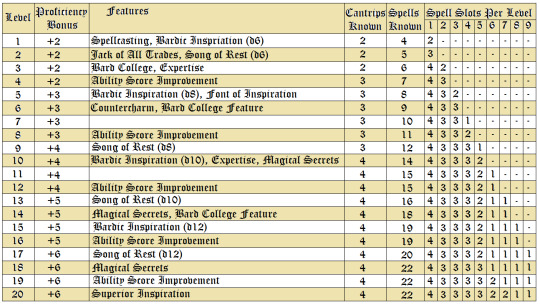
SPELLCASTING
You have learned to untangle and reshape the fabric of reality in harmony with your wishes and music. Your spells are part of your vast repertoire, magic that you can tune to different situations. See Spells Rules for the general rules of spellcasting and the Spells Listing for the bard spell list.
Cantrips
You know two cantrips of your choice from the bard spell list. You learn additional bard cantrips of your choice at higher levels, as shown in the Cantrips Known column of the Bard table.
Spell Slots
The Bard table shows how many spell slots you have to cast your bard spells of 1st level and higher. To cast one of these spells, you must expend a slot of the spell’s level or higher. You regain all expended spell slots when you finish a long rest. For example, if you know the 1st-level spell cure wounds and have a 1st-level and a 2nd-level spell slot available, you can cast cure wounds using either slot.
Spells Known of 1st Level and Higher
You know four 1st-level spells of your choice from the bard spell list. The Spells Known column of the Bard table shows when you learn more bard spells of your choice. Each of these spells must be of a level for which you have spell slots, as shown on the table. For instance, when you reach 3rd level in this class, you can learn one new spell of 1st or 2nd level. Additionally, when you gain a level in this class, you can choose one of the bard spells you know and replace it with another spell from the bard spell list, which also must be of a level for which you have spell slots.
Spellcasting Ability
Charisma is your spellcasting ability for your bard spells. Your magic comes from the heart and soul you pour into the performance of your music or oration. You use your Charisma whenever a spell refers to your spellcasting ability. In addition, you use your Charisma modifier when setting the saving throw DC for a bard spell you cast and when making an attack roll with one.
Spell save DC = 8 + your proficiency bonus + your Charisma modifier
Spell attack modifier = your proficiency bonus + your Charisma modifier
Ritual Casting
You can cast any bard spell you know as a ritual if that spell has the ritual tag.
Spellcasting Focus
You can use a musical instrument (see the Tools section) as a spellcasting focus for your bard spells.
BARDIC INSPIRATION
You can inspire others through stirring words or music. To do so, you use a bonus action on your turn to choose one creature other than yourself within 60 feet of you who can hear you. That creature gains one Bardic Inspiration die, a d6. Once within the next 10 minutes, the creature can roll the die and add the number rolled to one ability check, attack roll, or saving throw it makes. The creature can wait until after it rolls the d20 before deciding to use the Bardic Inspiration die, but must decide before the DM says whether the roll succeeds or fails. Once the Bardic Inspiration die is rolled, it is lost. A creature can have only one Bardic Inspiration die at a time. You can use this feature a number of times equal to your Charisma modifier (a minimum of once). You regain any expended uses when you finish a long rest. Your Bardic Inspiration die changes when you reach certain levels in this class. The die becomes a d8 at 5th level, a d10 at 10th level, and a d12 at 15th level.
JACK OF ALL TRADES
Starting at 2nd level, you can add half your proficiency bonus, rounded down, to any ability check you make that doesn’t already include your proficiency bonus.
SONG OF REST
Beginning at 2nd level, you can use soothing music or oration to help revitalize your wounded allies during a short rest. If you or any friendly creatures who can hear your performance regain hit points at the end of the short rest by spending one or more Hit Dice, each of those creatures regains an extra 1d6 hit points. The extra hit points increase when you reach certain levels in this class: to 1d8 at 9th level, to 1d10 at 13th level, and to 1d12 at 17th level.
BARD COLLEGE
At 3rd level, you delve into the advanced techniques of a bard college of your choice: the College of Lore detailed at the end of the class description or another from the Player's Handbook or other sources. Your choice grants you features at 3rd level and again at 6th and 14th level.
EXPERTISE
At 3rd level, choose two of your skill proficiencies. Your proficiency bonus is doubled for any ability check you make that uses either of the chosen proficiencies.
ABILITY SCORE IMPROVEMENT
When you reach 4th level, and again at 8th, 12th, 16th, and 19th level, you can increase one ability score of your choice by 2, or you can increase two ability scores of your choice by 1. As normal, you can’t increase an ability score above 20 using this feature.
FONT OF INSPIRATION
Beginning when you reach 5th level, you regain all of your expended uses of Bardic Inspiration when you finish a short or long rest.
COUNTERCHARM
At 6th level, you gain the ability to use musical notes or words of power to disrupt mind-influencing effects. As an action, you can start a performance that lasts until the end of your next turn. During that time, you and any friendly creatures within 30 feet of you have advantage on saving throws against being frightened or charmed. A creature must be able to hear you to gain this benefit. The performance ends early if you are incapacitated or silenced or if you voluntarily end it (no action required).
EXPERTISE
At 10th level, choose two more of your skill proficiencies. Your proficiency bonus is doubled for any ability check you make that uses either of the chosen proficiencies.
MAGICAL SECRETS
By 10th level, you have plundered magical knowledge from a wide spectrum of disciplines. Choose two spells from any classes, including this one. A spell you choose must be of a level you can cast, as shown on the Bard table, or a cantrip. The chosen spells count as bard spells for you and are included in the number in the Spells Known column of the Bard table. You learn two additional spells from any classes at 14th level and again at 18th level.
SUPERIOR INSPIRATION
At 20th level, when you roll initiative and have no uses of Bardic Inspiration left, you regain one use.

BARD COLLEGES
The way of a bard is gregarious. Bards seek each other out to swap songs and stories, boast of their accomplishments, and share their knowledge. Bards form loose associations, which they call colleges, to facilitate their gatherings and preserve their traditions.
College of Creation
Bards believe the multiverse was given existence through word and sound, esoteric harmonies that continue to resound through existence: the Song of Creation. The bards of this college draw on this ancient power through performances of dance, music, or song to bring into being what they need most. Members of this college might have developed their powers during experiences on other worlds or planes of existence. Those who have seen the commonalities of multiple realities might have learned how to tap into truths most mortals glimpse only for a moment. Alternatively, the bard might find themselves out of step with their own home plane, reality, or time, their connections to elsewhere allowing them to manipulate the space around them. Regardless of where a bard draws their powers from, other performers might be drawn to them, either to learn their secrets or to put an end to their dangerous manipulation of the Song of Creation.
3rd Level – Note of Potential
You can manipulate the Song of Creation to summon a floating musical note of possibility. Whenever you give a creature a Bardic Inspiration die, you can create a Note of Potential. The note orbits within 5 feet of the creature. The note is a Tiny object that is intangible and invulnerable, and it lasts until the Bardic Inspiration die is lost. A creature with a note can use it in the following ways.
Note of Destruction. Immediately after the creature rolls the Bardic Inspiration die to add it to an attack roll, the creature can expend the note to create a burst of sound. Each other creature within 5 feet of it must succeed on a Constitution saving throw against your spell save DC or take thunder damage equal to the number rolled on the Bardic Inspiration die.
Note of Protection. Immediately after the creature rolls the Bardic Inspiration die and adds it to a saving throw, the creature can expend the note to gain temporary hit points equal to the number rolled on the Bardic Inspiration die + your Charisma modifier, provided the creature doesn't already have temporary hit points.
Note of Ingenuity. When the creature rolls the Bardic Inspiration die to add it to an ability check, the creature can expend the note to roll the Bardic Inspiration die again and choose which roll to use.
6th Level – Animated Performance
Your mastery over the Song of Creation allows you to magically bring items to life. As an action, you can target a Large or smaller non-magical item you can see within 30 feet of you and animate it. The animate item uses the Dancing Item stat block and is under your control for 1 hour or until it is reduced to 0 hit points. In combat, the item shares your initiative count, but it takes its turn immediately after yours. It can move and use its reaction on its own, but the only action it takes on its turn is the Dodge action, unless you take a bonus action on your turn to command it to take one of the actions in its stat block or the Dash, Disengage, Help, Hide, or Search action. When you use your Bardic Inspiration feature, you can command which action your animated item takes as part of the same bonus action. Once you animate an item with this feature, you can’t do so again until you finish a long rest or until you expend a spell slot of 3rd level or higher to use this feature. You can have only one item animated by this feature at a time; if you use this action and already have a dancing item from this feature, the first one immediately becomes inanimate.
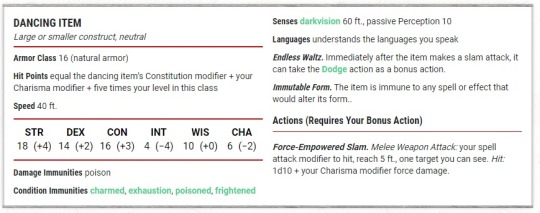
14th Level – Performance of Creation
Your performance can manipulate the magic of creation, briefly transforming the world around you. As an action, you can create one non-magical item of your choice in an unoccupied space within 10 feet of you. The item must appear on a surface or in a liquid that can support it. The gp value of the item can’t be more than 20 times your bard level and must be Large or smaller. Tiny glimmering, intangible notes float around it, and a creature can faintly hear music when touching it. For examples of items you can create, see the Armour, Weapons, Adventuring Gear, Tools, and Mounts and Vehicles tables in chapter 5, “Equipment,” of the Player’s Handbook. The created item disappears at the end of your next turn, unless you use your action to maintain it. Each time you use your action in this way, the item’s duration is extended to the end of your next turn, up to a maximum of 1 minute. If you maintain the item for the full minute, it continues to exist for a number of hours equal to your bard level. Once you create an item with this feature, you can’t do so again until you finish a long rest or until you expend a spell slot of 5th level or higher to use this feature. You can have only one item created by this feature at a time; if you use this action and already have an item from this feature, the first one immediately vanishes.
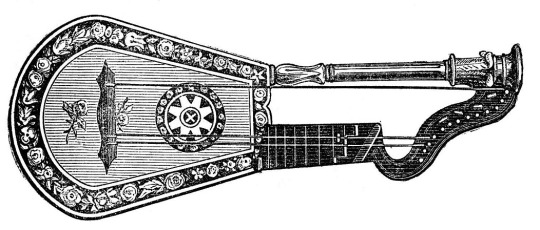
College of Eloquence
Adherents of the College of Eloquence master the art of oratory. Persuasion is regarded as a high art, and a well-reasoned, well-spoken argument often proves more powerful than objective truth. These bards wield a blend of logic and theatrical wordplay, winning over septics and detractors with logical arguments, and plucking at heartstrings to appeal to the emotions of entire audiences.
3rd Level – Universal Speech
You can now cast calm emotions without expending a spell slot. You can use this feature a number of times equal to your Charisma modifier. You regain all expended uses of this feature when you finish a long rest.
6th Level – Undeniable Logic
You can spin words laced with magic into a knot of reasoning that can be encouraging or impossible to follow. As a bonus action, you can expend one of your uses of Bardic Inspiration. When you do so, choose a creature you can see within 60 feet of you that can hear you, then roll your Bardic Inspiration die and choose one of the following:
The creature takes psychic damage equal to the number you roll on the Bardic Inspiration die, and the creature must succeed on an Intelligence saving throw against your spell save DC or have disadvantage on the next saving throw it makes before the end of your next turn.
The creature regains hit points equal to the number you roll on the Bardic Inspiration die, and the creature has advantage on the next saving throw it makes before the end of your next turn.
14th Level – Infectious Inspiration
When a creature adds one of your Bardic Inspiration dice to its ability check, attack roll, or saving throw and the roll fails, the creature can keep the Bardic Inspiration die. In addition, when a creature adds one of your Bardic Inspiration dice to its ability check, attack roll, or saving throw and the roll succeeds, you can use your reaction to encourage a different creature (other than yourself) that can hear you within 60 feet of you, giving it a Bardic Inspiration die without expending any of your Bardic Inspiration uses. You can use this reaction a number of times equal to your Charisma modifier (minimum of once), and you regain all expended uses when you finish a long rest.
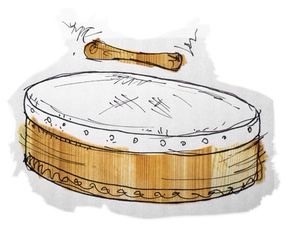
College of Lore
Bards of the College of Lore know something about most things, collecting bits of knowledge from sources as diverse as scholarly tomes and peasant tales. Whether singing folk ballads in taverns or elaborate compositions in royal courts, these bards use their gifts to hold audiences spellbound. When the applause dies down, the audience members might find themselves questioning everything they held to be true, from their faith in the priesthood of the local temple to their loyalty to the king. The loyalty of these bards lies in the pursuit of beauty and truth, not in fealty to a monarch or following the tenets of a deity. A noble who keeps such a bard as a herald or advisor knows that the bard would rather be honest than politic. The college’s members gather in libraries and sometimes in actual colleges, complete with classrooms and dormitories, to share their lore with one another. They also meet at festivals or affairs of state, where they can expose corruption, unravel lies, and poke fun at self-important figures of authority.
3rd Level – Bonus Proficiencies
When you join the College of Lore at 3rd level, you gain proficiency with three skills of your choice.
3rd Level – Cutting Words
Also at 3rd level, you learn how to use your wit to distract, confuse, and otherwise sap the confidence and competence of others. When a creature that you can see within 60 feet of you makes an attack roll, an ability check, or a damage roll, you can use your reaction to expend one of your uses of Bardic Inspiration, rolling a Bardic Inspiration die and subtracting the number rolled from the creature’s roll. You can choose to use this feature after the creature makes its roll, but before the DM determines whether the attack roll or ability check succeeds or fails, or before the creature deals its damage. The creature is immune if it can’t hear you or if it’s immune to being charmed.
6th Level – Additional Magical Secrets
At 6th level, you learn two spells of your choice from any class. A spell you choose must be of a level you can cast, as shown on the Bard table, or a cantrip. The chosen spells count as bard spells for you but don’t count against the number of bard spells you know.
14th Level – Peerless Skill
Starting at 14th level, when you make an ability check, you can expend one use of Bardic Inspiration. Roll a Bardic Inspiration die and add the number rolled to your ability check. You can choose to do so after you roll the die for the ability check, but before the DM tells you whether you succeed or fail.
Bard Spell List
https://burkesguidetodnd.tumblr.com/post/611674430339465216/bard-spell-list
3 notes
·
View notes
Text
Barbarian

People of towns and cities take pride in how their civilized ways set them apart from animals, as if denying one’s own nature was a mark of superiority. To a barbarian, though, civilization is no virtue, but a sign of weakness. The strong embrace their animal nature—keen instincts, primal physicality, and ferocious rage. Barbarians are uncomfortable when hedged in by walls and crowds. They thrive in the wilds of their homelands: the tundra, jungle, or grasslands where their tribes live and hunt. Barbarians come alive in the chaos of combat. They can enter a berserk state where rage takes over, giving them superhuman strength and resilience. A barbarian can draw on this reservoir of fury only a few times without resting, but those few rages are usually sufficient to defeat whatever threats arise.
Not every member of the tribes deemed “barbarians” by scions of civilized society has the barbarian class. A true barbarian among these people is as uncommon as a skilled fighter in a town, and he or she plays a similar role as a protector of the people and a leader in times of war. Life in the wild places of the world is fraught with peril: rival tribes, deadly weather, and terrifying monsters. Barbarians charge headlong into that danger so that their people don’t have to. Their courage in the face of danger makes barbarians perfectly suited for adventuring. Wandering is often a way of life for their native tribes, and the rootless life of the adventurer is little hardship for a barbarian. Some barbarians miss the close-knit family structures of the tribe, but eventually find them replaced by the bonds formed among the members of their adventuring parties.
When creating a barbarian character, think about where your character comes from and his or her place in the world. Talk with your DM about an appropriate origin for your barbarian. Did you come from a distant land, making you a stranger in the area of the campaign? Or is the campaign set in a rough-and-tumble frontier where barbarians are common? What led you to take up the adventuring life? Were you lured to settled lands by the promise of riches? Did you join forces with soldiers of those lands to face a shared threat? Did monsters or an invading horde drive you out of your homeland, making you a rootless refugee? Perhaps you were a prisoner of war, brought in chains to “civilized” lands and only now able to win your freedom. Or you might have been cast out from your people because of a crime you committed, a taboo you violated, or a coup that removed you from a position of authority.

HIT POINTS: 1d12 Per Barbarian Level
HIT POINTS AT 1st LEVEL: 1d12 + CON
PROFICIENCIES
ARMOUR: Light, Medium, Shields
WEAPONS: Simple, Martial
TOOLS: None
SAVING THROWS: Strength, Constitution
SKILLS: Animal Handling, Athletics, Intimidation, Nature, Perception, Survival (Choose 2)
STARTING EQUIPMENT
1. Great axe OR Any Martial melee weapon
2. Two handaxes OR Any simple weapon
3. Explorer’s pack AND Four javelins

FEATURES
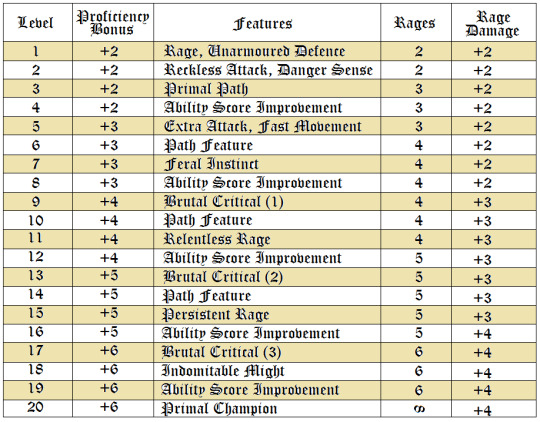
RAGE
In battle, you fight with primal ferocity. On your turn, you can enter a rage as a bonus action. While raging, you gain the following benefits if you aren’t wearing heavy armour:
You have advantage on Strength checks and Strength saving throws.
When you make a melee weapon attack using Strength, you gain a bonus to the damage roll that increases as you gain levels as a barbarian, as shown in the Rage Damage column of the Barbarian table.
You have resistance to bludgeoning, piercing, and slashing damage.
If you are able to cast spells, you can’t cast them or concentrate on them while raging.
Your rage lasts for 1 minute. It ends early if you are knocked unconscious or if your turn ends and you haven’t attacked a hostile creature since your last turn or taken damage since then. You can also end your rage on your turn as a bonus action. Once you have raged the number of times shown for your barbarian level in the Rages column of the Barbarian table, you must finish a long rest before you can rage again.
UNARMOURED DEFENCE
While you are not wearing any armour, your Armour Class equals 10 + your Dexterity modifier + your Constitution modifier. You can use a shield and still gain this benefit.
RECKLESS ATTACK
Starting at 2nd level, you can throw aside all concern for defence to attack with fierce desperation. When you make your first attack on your turn, you can decide to attack recklessly. Doing so gives you advantage on melee weapon attack rolls using Strength during this turn, but attack rolls against you have advantage until your next turn.
DANGER SENSE
At 2nd level, you gain an uncanny sense of when things nearby aren’t as they should be, giving you an edge when you dodge away from danger. You have advantage on Dexterity saving throws against effects that you can see, such as traps and spells. To gain this benefit, you can’t be blinded, deafened, or incapacitated.
PRIMAL PATH
At 3rd level, you choose a path that shapes the nature of your rage. The Path of the Berserker is detailed at the end of the class description, and additional primal paths are available in other sources. Your choice grants you features at 3rd level and again at 6th, 10th, and 14th levels.
ABILITY SCORE IMPROVEMENT
When you reach 4th level, and again at 8th, 12th, 16th, and 19th level, you can increase one ability score of your choice by 2, or you can increase two ability scores of your choice by 1. As normal, you can’t increase an ability score above 20 using this feature.
EXTRA ATTACK
Beginning at 5th level, you can attack twice, instead of once, whenever you take the Attack action on your turn.
FAST MOVEMENT
Starting at 5th level, your speed increases by 10 feet while you aren’t wearing heavy armour.
FERAL INSTINCT
By 7th level, your instincts are so honed that you have advantage on initiative rolls. Additionally, if you are surprised at the beginning of combat and aren’t incapacitated, you can act normally on your first turn, but only if you enter your rage before doing anything else on that turn.
BRUTAL CRITICAL
Beginning at 9th level, you can roll one additional weapon damage die when determining the extra damage for a critical hit with a melee attack. This increases to two additional dice at 13th level and three additional dice at 17th level.
RELENTLESS RAGE
Starting at 11th level, your rage can keep you fighting despite grievous wounds. If you drop to 0 hit points while you’re raging and don’t die outright, you can make a DC 10 Constitution saving throw. If you succeed, you drop to 1 hit point instead. Each time you use this feature after the first, the DC increases by 5. When you finish a short or long rest, the DC resets to 10.
PERSISTENT RAGE
Beginning at 15th level, your rage is so fierce that it ends early only if you fall unconscious or if you choose to end it.
INDOMITABLE MIGHT
Beginning at 18th level, if your total for a Strength check is less than your Strength score, you can use that score in place of the total.
PRIMAL CHAMPION
At 20th level, you embody the power of the wilds. Your Strength and Constitution scores increase by 4. Your maximum for those scores is now 24.

PRIMAL PATHS
Rage burns in every barbarian’s heart, a furnace that drives him or her toward greatness. Different barbarians attribute their rage to different sources, however. For some, it is an internal reservoir where pain, grief, and anger are forged into a fury hard as steel. Others see it as a spiritual blessing, a gift of a totem animal.
Path of the Beast
Barbarians who walk the Path of Beast draw their rage from a bestial spark burning within their souls. That beast howls to be released and bursts forth in the throes of rage. Those who tread this path might be inhabited by a primal spirit or descended from shapeshifters. You can choose the origin of your feral might or determine it randomly by rolling on the Origin of the Beast table.

3rd Level – Form of the Beast
When you enter your rage, you can transform, revealing the bestial power within you. Until your rage ends, you manifest a natural melee weapon, choosing one of the following options each time you rage:
Bite: Your mouth transforms into a bestial snout or great mandibles (your choice). Your bite deals 1d8 piercing damage on a hit. Once on each of your turns when you damage a creature with your bite, you regain a number of hit points equal to your Constitution modifier (minimum of 1 hit point).
Claws: Your hands transform into claws, which deal 1d6 slashing damage on a hit. When you take the Attack action on your turn and make an attack with your claws, you can make one additional attack using your claws as part of the same action.
Tail: You grow a lashing, spiny tail, which deals 1d12 piercing damage on a hit and has the reach property.
6th Level – Bestial Soul
The feral spirit within you grows in power, causing the natural weapons of your Form of the Beast to count as magical for the purpose of overcoming resistance and immunity to non-magical attacks and damage. You can also call on the feral spirit to help you adapt to your surroundings. When you finish a short or long rest, choose one of the following benefits, which lasts until you finish a short or long rest:
Climbing: You gain a climbing speed equal to your walking speed, and you can climb difficult surfaces, including upside down on ceilings, without needing to make an ability check.
Jumping: When you jump, you can make a Strength (Athletics) check and extend your jump by a number of feet equal to the check’s total. You can make this special check only once per turn.
Swimming: You gain a swimming speed equal to your walking speed, and you can breathe underwater.
10th Level – Infectious Fury
When you hit a creature with your natural weapons while you are raging, the spirit within you can curse your target with rabid fury. The target must succeed on a Wisdom saving throw (DC equal to 8 + your Constitution modifier + your proficiency bonus) or suffer one of the following effects (your choice):
The target must use its reaction to make a melee attack against another creature of your choice that you can see.
Target takes 2d12 psychic damage.
You can use this feature a number of times equal to your Constitution modifier (a minimum of once). You regain all expended uses when you finish a long rest.
14th Level – Call the Hunt
The beast within grows so powerful that you can spread its ferocity to your allies. When you enter your rage, you can choose a number of willing creatures you can see within 30 feet of you equal to your Constitution modifier (minimum of one creature). Until your rage ends, the chosen creatures gain the Reckless Attack feature and you have advantage on saving throws against being frightened. You also gain 5 temporary hit points for each creature that accepts the benefit. You can use this feature a number of times equal to your Constitution modifier (a minimum of once). You regain all expended uses when you finish a long rest.

Path of the Berserker
Starting when you choose this path at 3rd level, you can go into a frenzy when you rage. If you do so, for the duration of your rage you can make a single melee weapon attack as a bonus action on each of your turns after this one. When your rage ends, you suffer one level of exhaustion.
3rd Level – Frenzy
Starting when you choose this path at 3rd level, you can go into a frenzy when you rage. If you do so, for the duration of your rage you can make a single melee weapon attack as a bonus action on each of your turns after this one. When your rage ends, you suffer one level of exhaustion.
6th Level – Mindless Rage
Beginning at 6th level, you can’t be charmed or frightened while raging. If you are charmed or frightened when you enter your rage, the effect is suspended for the duration of the rage.
10th Level – Intimidating Presence
Beginning at 10th level, you can use your action to frighten someone with your menacing presence. When you do so, choose one creature that you can see within 30 feet of you. If the creature can see or hear you, it must succeed on a Wisdom saving throw (DC equal to 8 + your proficiency bonus + your Charisma modifier) or be frightened of you until the end of your next turn. On subsequent turns, you can use your action to extend the duration of this effect on the frightened creature until the end of your next turn. This effect ends if the creature ends its turn out of line of sight or more than 60 feet away from you. If the creature succeeds on its saving throw, you can’t use this feature on that creature again for 24 hours.
14th Level – Retaliation
Starting at 14th level, when you take damage from a creature that is within 5 feet of you, you can use your reaction to make a melee weapon attack against that creature.

Path of the Wild Soul
The realm of the Feywild abounds with beauty, unpredictable emotion, and rampant magic. A barbarian exposed to this realm feels emotions powerfully and magic saturates their body. When a barbarian who follows this path rages, it is a bellowing roar for freedom, an explosion of expression, manifesting in unpredictable ways.
3rd Level – Lingering Magic
At 3rd level, your body reacts to the presence of magic. You can cast the detect magic spell without using a spell slot or components. Constitution is your spellcasting ability for this spell. You faintly glow a colour corresponding to the school of magic you detect (you choose the colours). You can use this feature a number of times equal to your Constitution modifier (minimum of once). You regain all expended uses when you finish a long rest.
3rd Level – Wild Surge
Starting at 3rd level, magic erupts from you as you rage. When you enter your rage, roll on the Wild Surge table to determine the magical effect produced. If the wild surge requires a saving throw, the DC equals 8 + your proficiency bonus + your Constitution modifier.
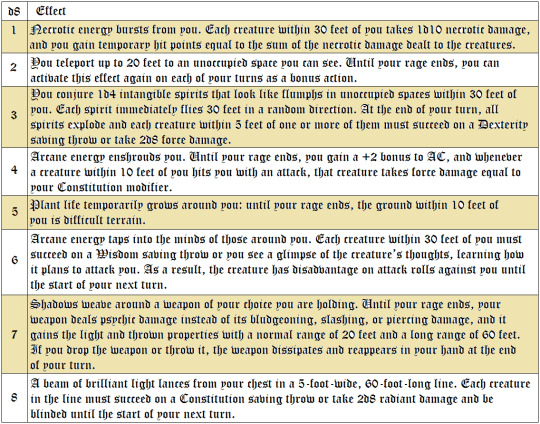
6th Level – Magic Reserves
At 6th level, you can channel the magic surging inside you into other creatures. As an action, you can touch a creature and roll a d4. The creature recovers an expended spell slot of a level equal to the number rolled. If the creature you touch can’t recover a spell slot of that level, the creature instead gains temporary hit points equal to five times the number rolled. You take force damage equal to five times the number rolled. When you reach 14th level in this class, you increase the die to a d6.
10th Level – Arcane Rebuke
At 10th level, the magic crackling within your soul lashes out. When a creature forces you to make a saving throw while you are raging, you can use your reaction to deal 3d6 force damage to that creature.
14th Level – Chaotic Fury
At 14th level, you become a wellspring of wild magic while you are raging. As a bonus action, you can reroll on the Wild Surge table, replacing your current effect with the new one.
3 notes
·
View notes
Note
What's your race recommendation? (Which race would you choose?)
That depends entirely on how challenging you want your game to be. D&D is a roll playing game, so the races and classes furthest from your actual life will take the most effort. If you want to play an easy game, where you can play more or less as yourself, then choose Human. If you want to play a completely different life altogether, try a Dragonborn or Tiefling. On the whole: Humans - Take very little roll play. Gnomes - Basically happy, cheery humans. Dwarves - Basically grumpy humans. Halfling - Sneaky, charismatic, confident Elves - Snobbish, arrogant, extremely confident Half-Elf - Uncertain about themselves, confused Half-Orc - Angry, violent, distrustful Dragonborn - Defensive, noble, mysterious Tiefling - Furious, dangerous, unpredictable
2 notes
·
View notes
Note
If you're a half orc, does that mean you're a 'bad' guy?
Absolutely not. Orcs are chaotic, but not necessarily evil. Remember, nobody believes they’re the ‘bad guy’. Everyone sees everything from their own point of view. To a human, goblins raiding a village would be the bad guys. To the goblins, the humans who built a village in the middle of their land are the bad guys.
1 note
·
View note